

Wild Life Natural wonders
How rewilding is reviving threatened species
SIX PLACES TO HEAR
Summer symphony
A chorus of crickets and grasshoppers
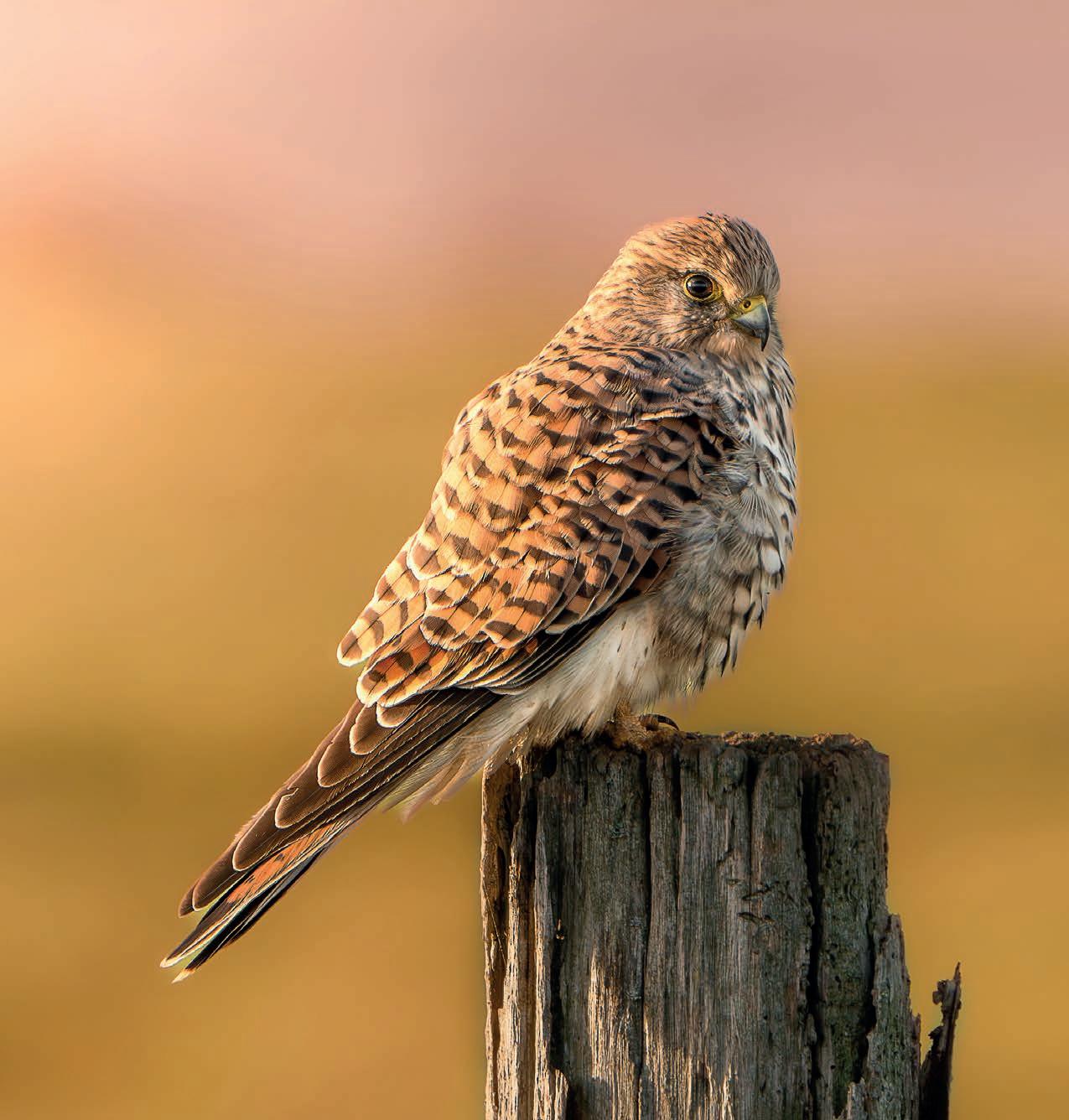
CHAMPIONS FOR CHANGE
Wild at heart
Meet the gardeners who rewrite the rules for nature

Digital copies of Wild Life magazine are also available. If you would prefer to receive a digital copy, please email membership@hiwwt.org.uk and we will update your record.
Restoring nature to abundance

Nature is in crisis. Climate change is intensifying the pressure on wildlife, causing habitats to shift or vanish — but there is hope. Rewilding, which aims to reverse ecological damage and restore lost habitats and species, is at the heart of our work (see page 18 to learn more). At Wilder Little Duxmore on the Isle of Wight, rewilding has transformed depleted farmland into a vibrant, biodiverse haven (page 22). Elsewhere, threatened species have been supported on our reserves this
summer with hazel dormice discovered in nest boxes at Swanpond Copse after a seven-year absence, while at Blashford Lakes, a specially designed nesting tower now offers a safe home for red-listed swifts and house martins (see page 10).
In the Itchen Valley, habitat enhancement is tackling the decline of Atlantic salmon and helping to protect the health of the River Itchen (page 11), while Basingstoke & Deane Borough Council has taken the bold move to create a ‘Rights of the River’ declaration, which will offer greater protection for their local rivers, with other local councils potentially following their lead. Learn more at hiwwt.org.uk/rivers
And this season, we’re proud to share that our Chief Executive, Debbie Tann MBE, has been named one of the UK’s top 100 environmental professionals in the ENDS Power List 2025, recognising her visionary leadership. On page 16, she reflects on our responsibility to create a legacy of hope, inspired by Sir David Attenborough’s latest documentary, Oceans
We’ve also joined forces with the Wildlife Trusts and others to challenge
Hampshire & Isle of Wight Wildlife Trust
Wild Life is the membership magazine for Hampshire & Isle of Wight Wildlife Trust.
Registered charity number 201081. Company limited by guarantee and registered in England and Wales No. 676313. Website hiwwt.org.uk
● We manage 70 nature reserves.
● We are supported by over 29,000 members and friends, and 1,500 volunteers.
Editor Sara Mills
Designer Keely Docherty-Lee
Hampshire & Isle of Wight Wildlife Trust is registered with the UK Fundraising Regulator. We aim to meet the highest standards in the way we fundraise.
Cover image Kestrel resting at Farlington Marshes © Debbie Ellaway
the Government’s proposed changes to nature protections in Part 3 of the Planning and Infrastructure Bill. As we go to print, the Bill is progressing through Parliament and we will continue to push for the best outcome for wildlife and people.
Every success we achieve is thanks to the passion, innovation, and dedication of our staff, volunteers, partners, and supporters. For this, we are truly grateful. We encourage you to continue raising your voice to MPs and taking steps — large or small — to support nature.
As this flourishing season continues, we reflect on the progress we’ve made and the people driving that change. We look forward to honouring our conservation champions at this year’s Wilder Conference & Awards. For details on a day that promises inspiration, action, and celebration, see the back page.

Sara Mills, Editor
Email: editor@hiwwt.org.uk

You can change your contact preferences at any time by contacting Hampshire & Isle of Wight Wildlife Trust at:
Email membership@hiwwt.org.uk
Telephone 01489 774400
Address Beechcroft House, Vicarage Lane, Curdridge, Hampshire SO32 2DP
For more information on our privacy notice visit hiwwt.org.uk/privacy-notice
Please pass on or recycle this magazine once you’ve finished with it.
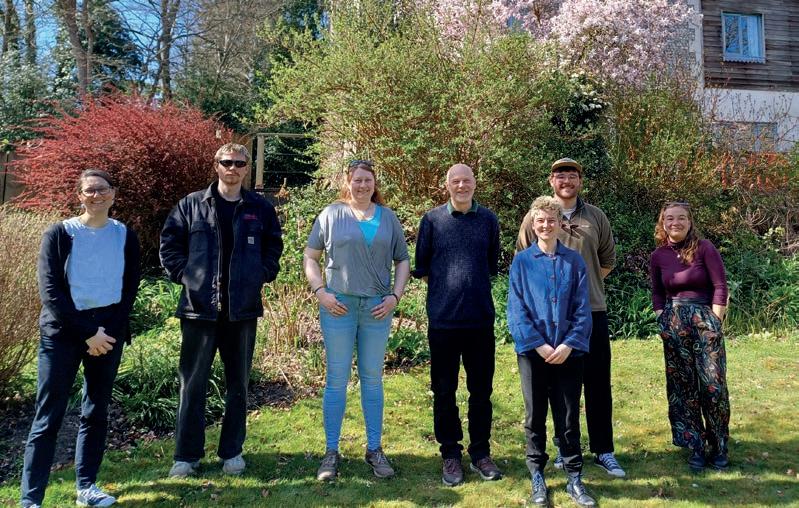
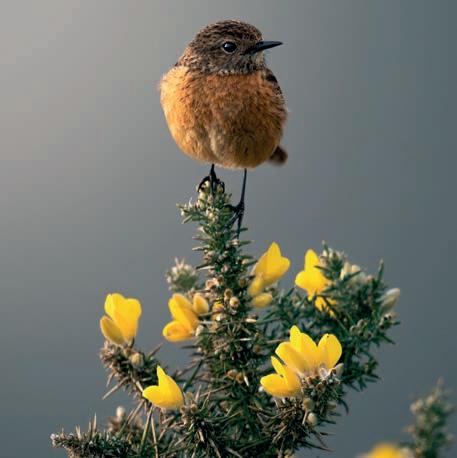
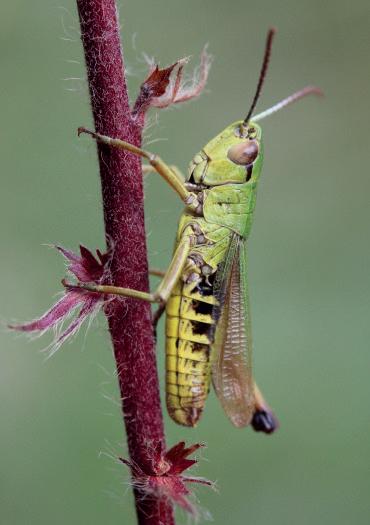
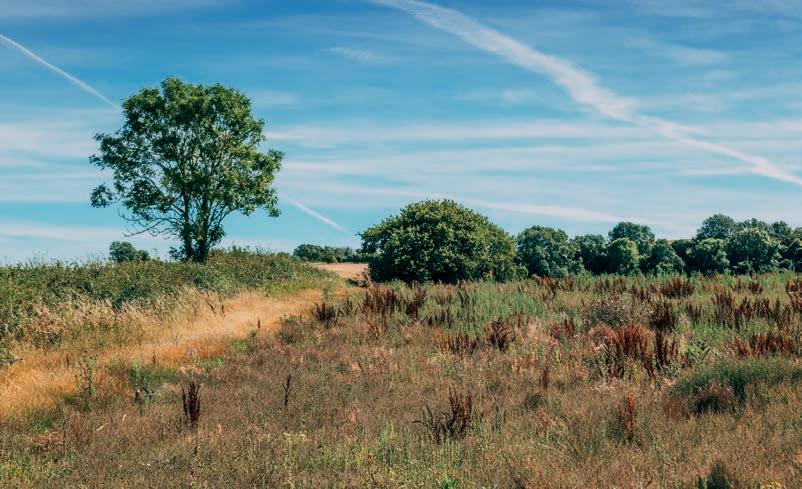
WILD SEASON
4 Your wild summer
The best of this season’s nature, including the versatile peregrine falcon.
8 Reserves spotlight
A closer look at Hawley Common with its abundant heathland and majestic Scots pines.
10 Wild news
A round-up of the latest Trust news, successes and updates.
14 Team Wilder
How people and communities are pulling together for a wilder future.
FEATURES
18 What is rewilding?
We dig deeper into the practice of rewilding and how it revitalises habitats and wildlife at scale.
22 Li le Duxmore, five years on
We take a closer look at the transformation of one of the Isle of Wight’s most nature-depleted sites.
REGULARS
16 A word from our CEO Reflections and strategy from Debbie Tann, MBE, Hampshire & Isle of Wight Wildlife Trust Chief Executive.
26 Six places to hear
A highlight of the vibrant chorus of crickets and grasshoppers and where to spot them.
28 Wildlife gardening
Get inspired: Garden Champion Jane Rankine showcases ways to create more habitats for nature.
30 My wild life
A celebration of the careers of our longest-serving staff members.
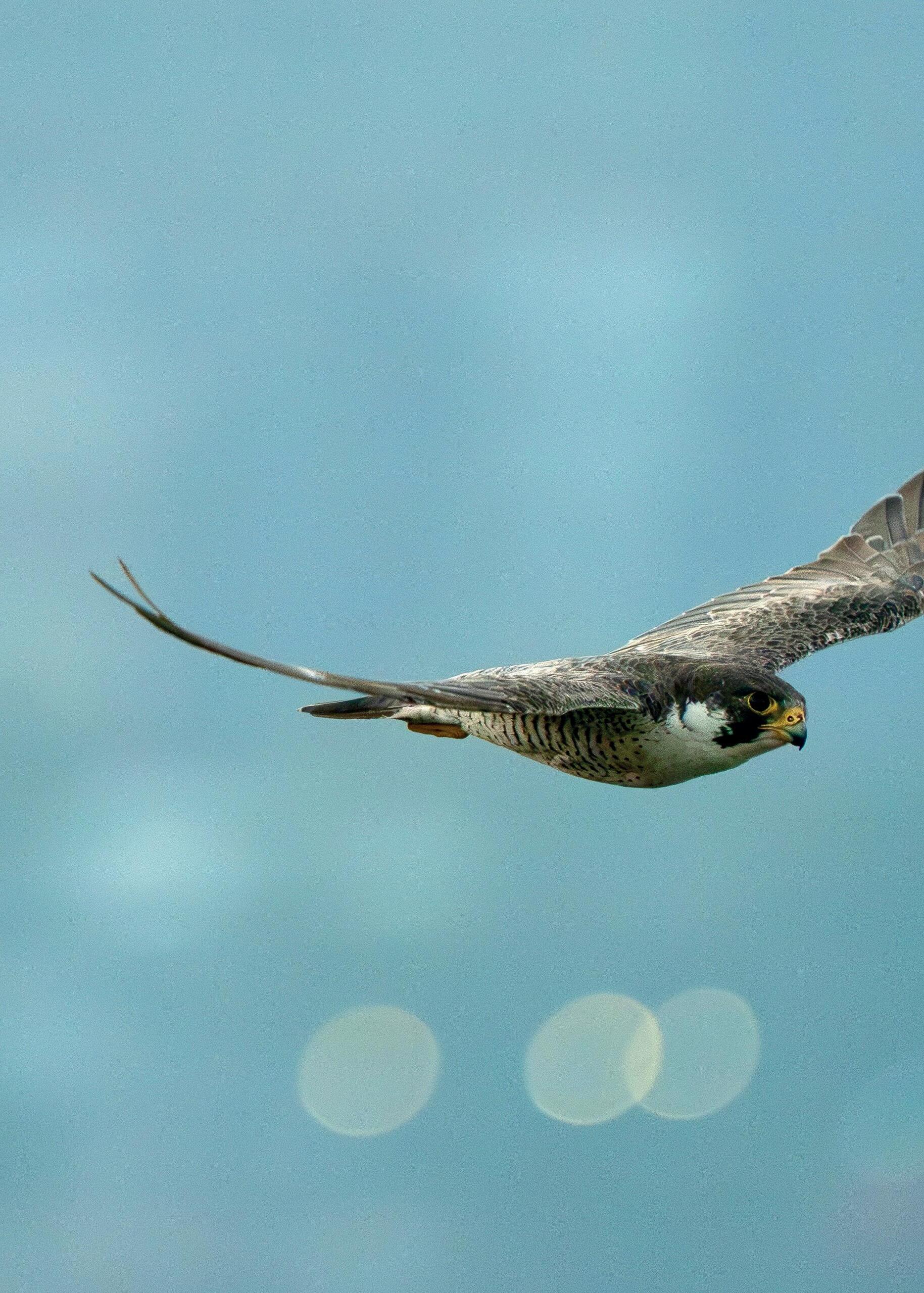
Your wild summer
The best of the season’s wildlife and where to enjoy it.
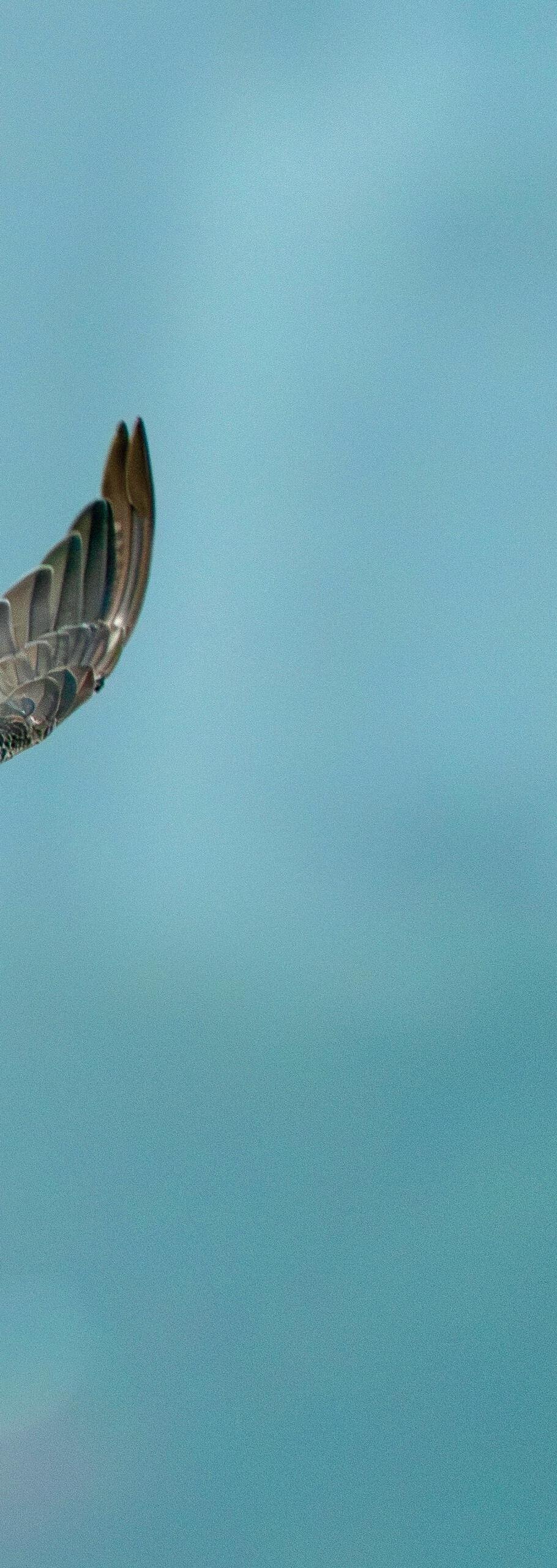
SUMMER SPECTACLE
Peregrines on the rise
Once pushed to the brink of extinction in the UK due to persecution and pesticide use, the peregrine falcon has made a dramatic and inspiring comeback. Now one of our most iconic top predators, peregrines, Falco peregrinus, are increasingly being seen not just in remote cliffs and moorlands, but also high above our towns and cities. Their resurgence in the south is a powerful symbol of nature’s resilience and the benefits of rewilding in both rural and urban landscapes.
Thanks to legal protection, conservation efforts, and cleaner ecosystems, peregrines are now a more common sight for bird watchers. Their success also mirrors broader shifts happening across the countryside and our urban spaces. As Wilder initiatives take root - restoring habitats, reconnecting ecosystems, and making space for nature - they create the conditions needed for complex food webs to return. This means more insects, more small birds and mammals, and in turn, more opportunities for apex predators like the peregrine to hunt and breed.
Capable of reaching speeds over 200 mph during their stoop, the iconic dive used to catch prey mid-air, they are the fastest bird on the planet. eir fierce agility, sharp eyesight, and distinctive black-and-white facial markings have long captured the public imagination. But their growing presence is more than just thrilling to witness, it’s a sign that nature is healing.
Breeding season
Peregrines exhibit remarkable territorial behaviour, often returning to the same nesting site year after year. These raptors are highly vocal during the breeding season and ercely defend their chicks from intruders, including much larger birds.
From quarries to quaysides, and from woodland edges to city skylines, peregrines are not just returning, they’re adapting. Once associated with nesting in high, out-ofthe-way spots such as clifftops, they have since been spotted circling the tall chimneys at Fawley oil refinery, resting on Southsea Castle’s sea wall while hunting for incoming sea birds, perched on pylons at Lower Test Nature Reserve and sitting on top of Romsey Abbey’s weathervane. Their success reflects how nature, when given the chance, can respond with resilience and ingenuity. As ecosystems recover, so too do the species within them, finding new niches, new behaviours, and new ways to thrive. The presence of peregrines is both a testament to this adaptability and a call to action: when we create space for nature, everything from wildflowers to raptors has a chance to return.
This summer, whether you’re walking in the hills or glancing up from a city square, keep your eyes on the skies. You might just glimpse a peregrine in flight, a living symbol of a wilder, richer future.
PHOTO: SHUTTERSTOCK
From villain to vital
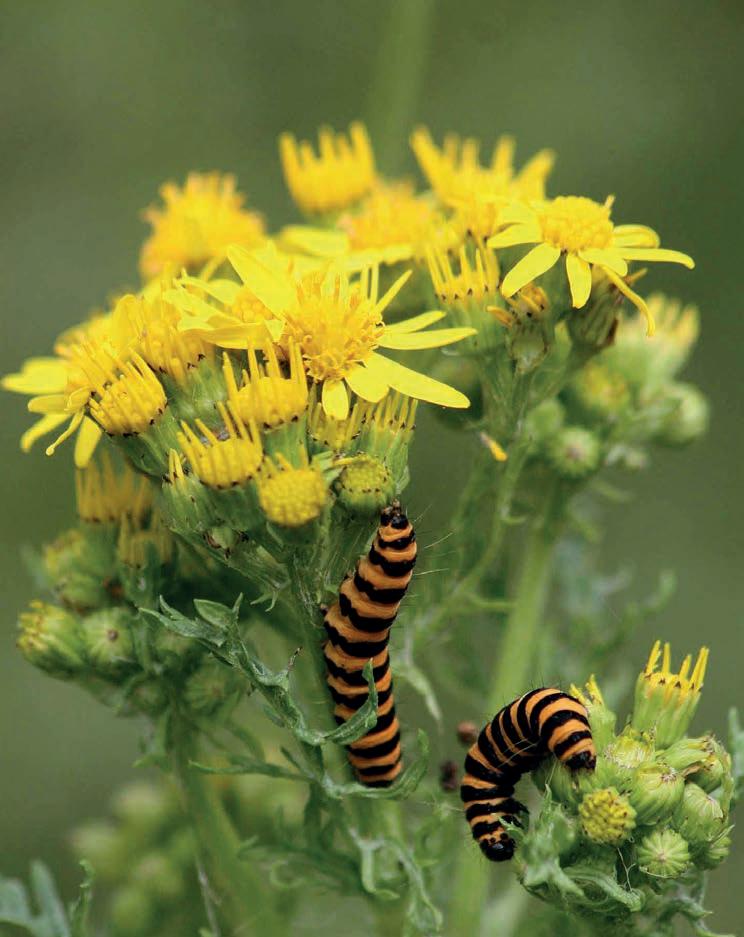
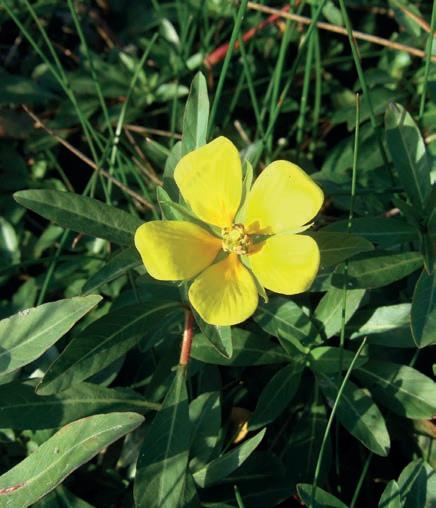
Often misunderstood because of its toxic properties, common ragwort is, in fact, a valuable haven for wildlife. when allowed to grow in the right places.
From June to November, its clusters of yellow, daisy-like flowers provide nectar and pollen for a wide range of pollinators. Ragwort is one of the most frequently visited flowers by butterflies in the UK, and over 200 invertebrate species have been recorded using it.
Most famously, it is the food plant of the striking cinnabar moth, Tyria jacobaeae. Its black-and-yellow caterpillars feed almost exclusively on ragwort, absorbing the plant’s toxins to deter predators. Without ragwort, this beautiful moth would vanish from many landscapes.
Common ragwort thrives in diverse habitats, grasslands, coastal areas, brownfield sites, and even town edges, and is a key part of wilder, more balanced ecosystems.
People often worry when they see livestock grazing where ragwort is present. Although ragwort, like other native plants such as daffodils and bluebells, can be toxic to livestock if consumed in large quantities, most animals naturally avoid it due to its bitter, unpalatable taste.
As we work to bring wildlife back, it’s vital to rethink our relationship with plants like ragwort. In the right places, it’s not a problem. It’s part of the solution.
Pervading water primrose
Did you know a quiet threat could be growing in Hampshire’s wild waters?
Invasive species like water primrose, Ludwigia grandiflora, look harmless, but they’re putting pressure on our delicate river ecosystems and native wildlife. Originally from South America, the water primrose was introduced to the UK through the aquatic plant trade for ornamental ponds. But from garden water features it has escaped into the wild, and is spreading rapidly across southern England, including Hampshire. The water primrose poses a potential threat to rivers and wetlands due to its rapid spread, forming thick, impenetrable
mats on the surface of ponds, streams, and ditches. Recognised by its bright yellow flowers (which bloom in July to September) its sprawling stems reach across the water’s surface and grow upright. Preferring ponds, lakes, and slow-moving streams, it is often confused with harmless native species like brooklime and water mint, so accurate identification is key.
If you think you have spotted any water primrose, please report any sightings to Joanne Gore, Ecologist at the Trust: joanne.gore@hiwwt.org.uk
To find out more, visit hiwwt.org.uk/ news/waterprimrose
LINDA PRIESTLEY
Cinnabar moth caterpillar on common ragwort.
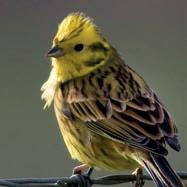
HEAR THIS
With its bright head and chest and streaky brown back, the sparrow-sized yellowhammer has a rhythmic song that sounds like ‘a little bit of bread and no cheese’.
SPECIES SPOTLIGHT
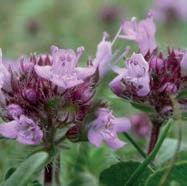
SMELL THIS
For a sensory treat, venture across the chalk grassland of the South Downs Way. On warm days, wild thyme scents the air with hints of lavender, mint, and earthiness.
Jam-packed with charm
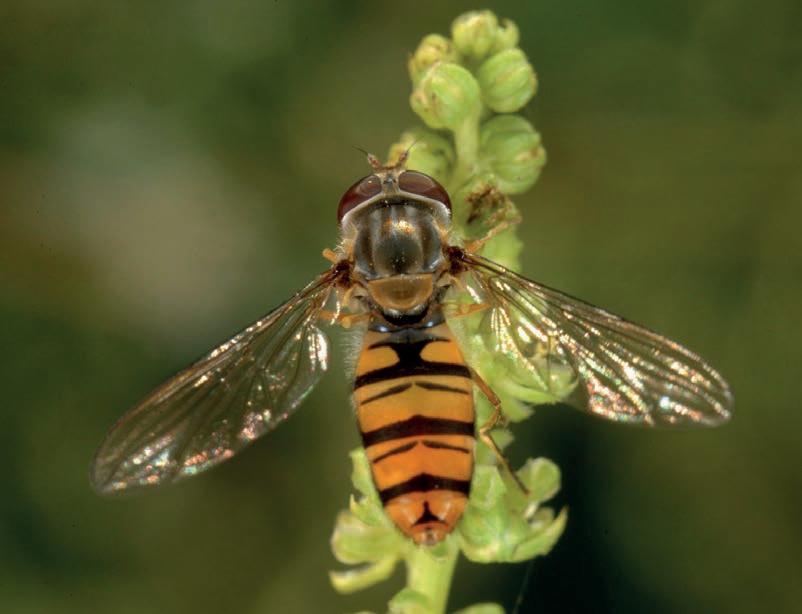
Unlike bees, hoverflies can hover motionless in the air before darting to their next flower.
The marmalade hoverfly, Episyrphus balteatus, is one of the most common and recognisable hoverflies in Britain.
It gets its name from its orange colour, and the different sized black bands across its body: ‘thin cut’, ‘thick cut’, just like marmalade! With its orange-andblack striped body, it is often mistaken for a wasp, but this harmless insect plays a vital role in the ecosystem. Hoverflies are among our most important pollinators, visiting a wide range of flowers and ensuring plants can produce seeds and fruit. Unlike bees and butterflies, they are active throughout much of the year, even in cooler months when other pollinators are scarce. They are the second most significant pollinator after bees, and marmalades are particularly drawn to the likes of daisies, asters, yarrow and
single-flowered dahlias.
Unlike bees, hoverflies can hover motionless in the air before darting to their next flower. This hovering ability, along with their striking colours, makes them a joy to watch. They also provide natural pest control. The larvae of the marmalade hoverfly feed on aphids, making them a gardener’s ally by reducing the need for chemical pesticides. A single larva can consume hundreds of aphids during its development, helping to keep planteating pests in check. This makes hoverflies a crucial part of sustainable agriculture and wildlife-friendly gardening.
To learn more about hoverflies and how to support them, visit hiwwt.org. uk/wildlife-explorer/invertebrates/ flies/marmalade-fly
Roe deer
In summer, the shy roe deer likes to roam alone through thickets of ancient woodland, as well as a mix of chalk valleys, farmland, grassland and heath. Identifiable by its pale rump, it feeds on buds and leaves of trees as well as ferns, grasses and heathers.
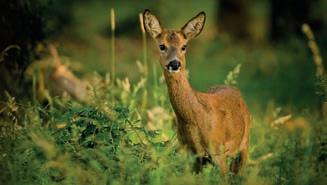
Six-spot burnet moth
From June to August, look out for this striking day-flying moth which favours feeding on knapweed and thistles. It flies with a slow, fluttering pattern and its dramatic red spots warn predators that they are poisonous to eat.
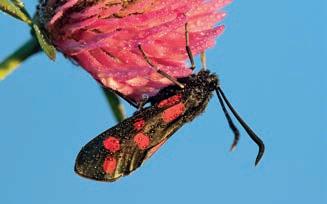
Adonis blue
The Adonis blue is one of the rarest butterflies in the UK. Found on sunny, south-facing grassland rich in herbs, the males are a vivid sky-blue, fringed with fine black lines and a white edge, while females tend to be a duller brown.
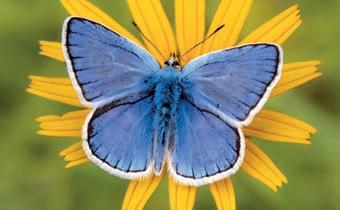
PHILIP PRECEY
DAVID KILBEY
BRIAN EVERSHAM
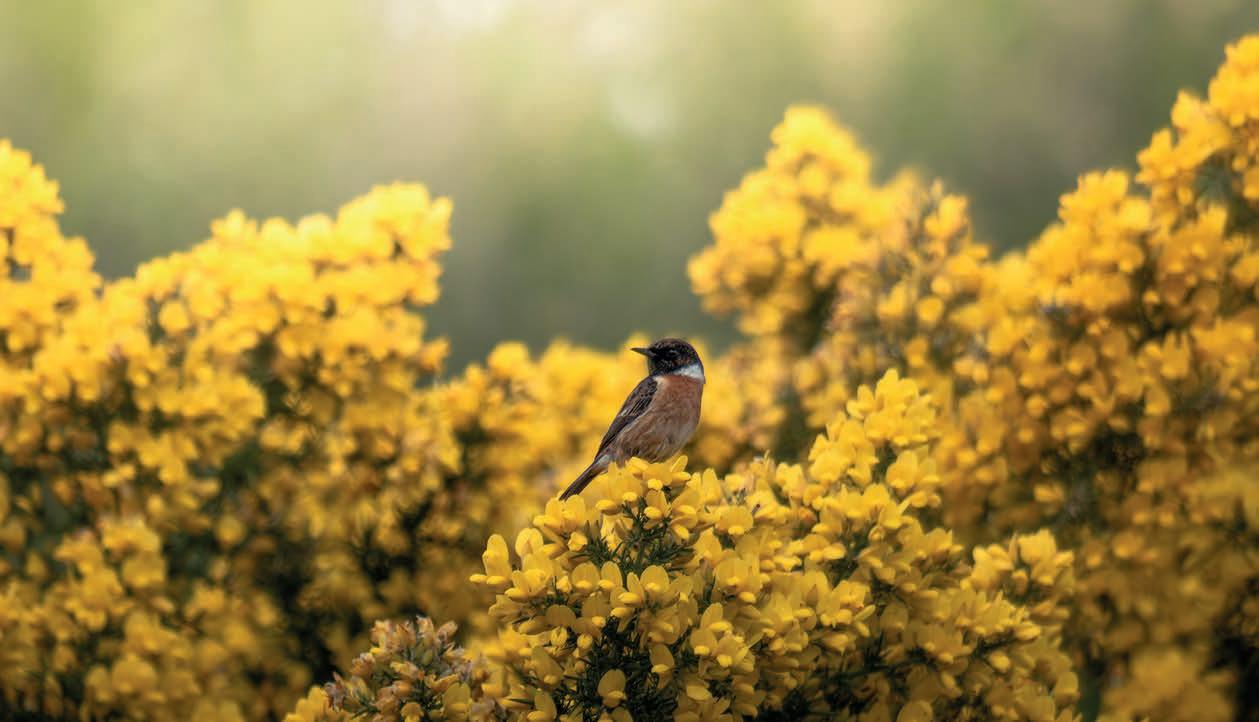
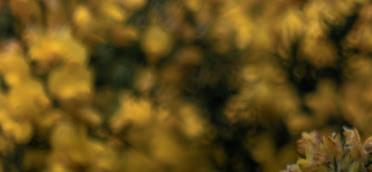
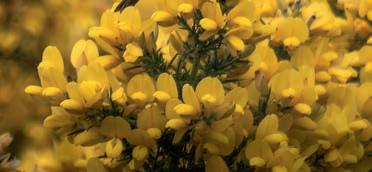
Discover Hawley Common
Just north of Hawley Lake in Minley, lies Hawley Common: its richly wooded heathland with wide, sandy tracks runs through tall pines interspersed with slender silver birches and swathes of vibrant yellow gorse. This designated Special Protection Area (SPA) is an internationally important habitat for rare species of ground-nesting birds such as the Dartford warbler, woodlark and nightjar. It is one of 10 areas in north Hampshire, managed by the Trust in collaboration with the Ministry of Defence (MOD), who own the land and use it for military training. But it is
also accessible to members of the public looking for peaceful nature walks.
Globally rare lowland heath
According to Natural England, the UK holds about 20% of the world’s remaining lowland heath, making Hawley Common a rare and vital habitat. This 55-hectare (136 acres) MOD site resides within a larger network of heathland extending over 8,200 hectares (20,263 acres) across Hampshire, Surrey and Berkshire. Known for its outstanding assemblage of dragonflies and damselflies, it also supports a diverse array of delicate
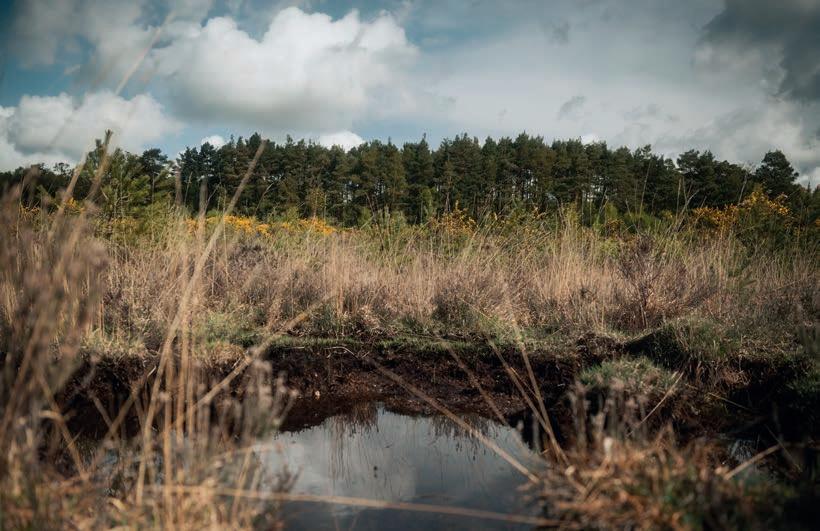
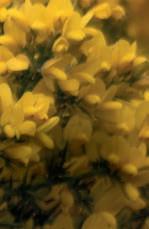
heathers, carnivorous sundew, prickly star sedge and rare marsh clubmoss, as well as reptiles such as grass snakes, slow-worms and the common lizard.
Growing conditions
The sandy, acidic and free-draining heathland soils create ideal conditions for a range of hardy plants and trees such as common and bell heathers, gorse, broom, bracken, Scots pine and silver birch. As heathland management declined throughout the ages, the faster growing gorse and scrub species began to dominate and eradicate areas of the slower-growing heather and shade out or dry up other parts of the heath. To combat this, a range of techniques are employed to restore and maintain open heath, including through grazing and the cutting of scrub by hand or machinery.
Pony and cattle grazing
An essential part of any heathland management plan is the use of grazing.
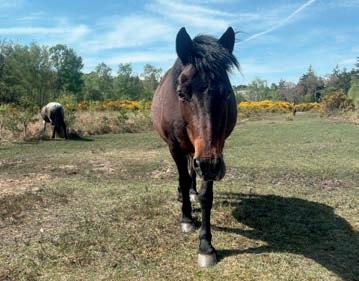
New Forest pony
Wet heathland provides a refuge for aquatic life.
History of the commoners
During the Medieval period, large areas of Hampshire would have been lowland heathland. Hawley was once part of a string of Medieval hamlets along the Blackwater, with communities utilising common land for grazing and other resources such as firewood and peat. The first written record of Hawley, including the common, dates to 1248. Commoners at Minley, like those throughout the New Forest, would have exercised their rights on common land to graze livestock, including ponies, cattle, and donkeys which helped keep it “open” and maintain the heathland. When common grazing declined in the early twentieth century, the heathland started to grow over.
The munching, nibbling and trampling of small herds of ponies and cattle as they wander freely across the land, create the perfect conditions for new plants and insects, which in turn supports birds and mammals. Eight New Forest ponies, belonging to a grazier in the New Forest, and four Shetland cows (Jet, J’adore, Jeans and Jura) are put out for grazing by the Trust. These hardy breeds poach the ground with their hooves, overturning the soil and spreading plant seeds to create a rich mosaic of habitats. Their manure is a great source of nutrients for many insects and species of fungi, and their voracious appetite keeps spiky, fast-growing plants at bay. The cattle like to wrap their tongues around the plants to pull them up, leaving patches of vegetation at uneven heights which enables a greater variety of plants and insects to establish themselves.
Healthy heathland
The ideal mix of heathland includes plants of different ages and species with areas of common heather as well as ericaceous shrubs like bell heather and cross-leaved heath. It should also have areas of bare ground and wet heath, or mire. Scrub provides areas for foraging and groundnesting birds, reptiles such as common lizards like to bask in the soft sandy open patches, while water-logged soils support aquatic insects. All these habitats support each other, benefitting a wide range of wildlife, from fungi to plants, insects to reptiles, birds to mammals.
What to expect if you visit
In summer, the site comes alive with the scent of coconut-smelling gorse and the song of woodlark, and the distinctive drill of the great spotted woodpecker, as well as the whirling and darting of dragonflies and damselflies across the mire. Deep in summer, nightjars will be churring from
dusk and at dawn. Exploring the sights on the circular 8.3-mile walk around Hawley Common takes about three hours. And if you start and end at the pub, some cold refreshments will be well deserved.
Visit Hawley Common
KNOW BEFORE YOU GO
The site is MOD ‘managed access’ land, used for military training, so pay attention to signage and information. When visiting, move well away from any areas where the Army are training. Never touch any military debris. Other MOD sites may have different access provisions.
Location: There are several different access points – the main one is a private road accessible from Minley Road between the Gibraltar Barracks’ main entrance and the Crown and Cushion pub in Minley, OS Maps grid reference: SZ 609 655. what3words reference: ///fever.inflamed.tasty
Parking: There are two access points: Hawley Memorial Hall car park, Fernhill Road, Blackwater: OS Maps grid reference: SU8559 or outside Hawley Lake Sail Training Centre’s main gate. If you are using a Sat Nav, use GU17 9UD to get to the approach road. OS Maps reference: SU 834575.
Reserve size: 55 hectares (136 acres). Getting around: Public footpaths run through the site with sandy freegrazing tracks to walk around. Busy times and access: Weekends and bank holidays, otherwise a quiet spot for dog walkers, although we ask that you keep dogs on leads at all times on our reserves.
Wildlife to spot
Woodlark
In spring and summer, the gentle song of the woodlark lilts over the heathland and open areas. This streaky brown and white bird has a small distinctive crest and uses scattered trees and woodland edges as lookout posts.
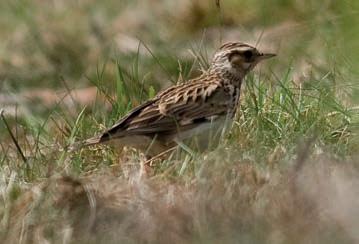
Sundew
The round-leaved sundew traps and digests insects – an adaptation to its nutrient-poor habitat.
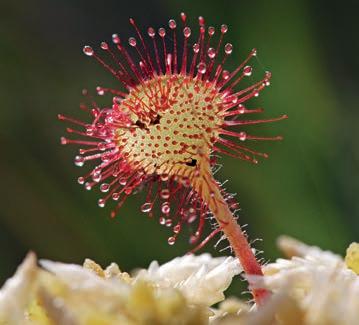
Red kite
This magnificent bird of prey can often be spotted circling over the open scrub at Hawley Common, identifiable by its unmistakable reddish-brown body, angled wings and forked tail.
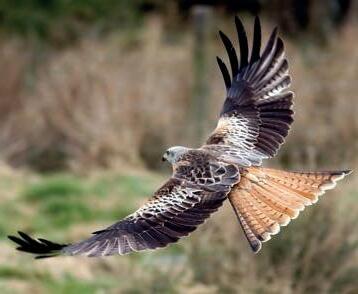
All the latest news from Hampshire & Isle of Wight Wildlife Trust
New nesting tower gives swi s and house martins a lifeline
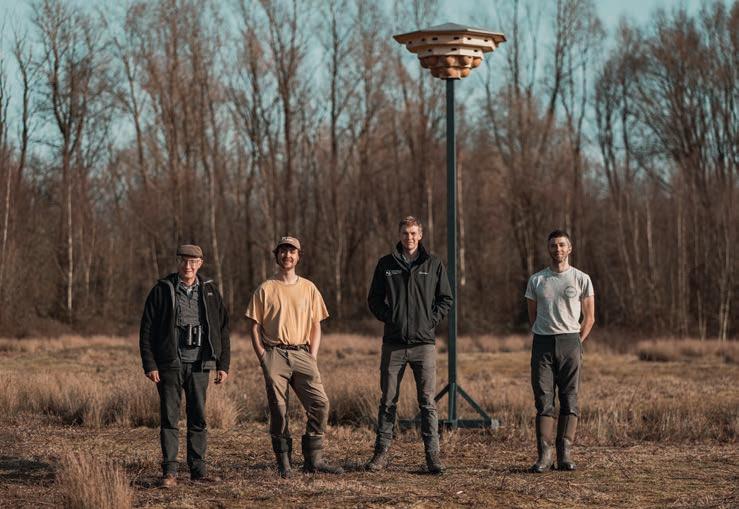



Swi s spend almost their entire lives in flight – eating, sleeping, and even mating on the wing.


Tim Norris from Hampshire Swifts, Jack Medley, the Trust’s Reserves Officer at Blashford Lakes, and contractors from Peak Boxes.

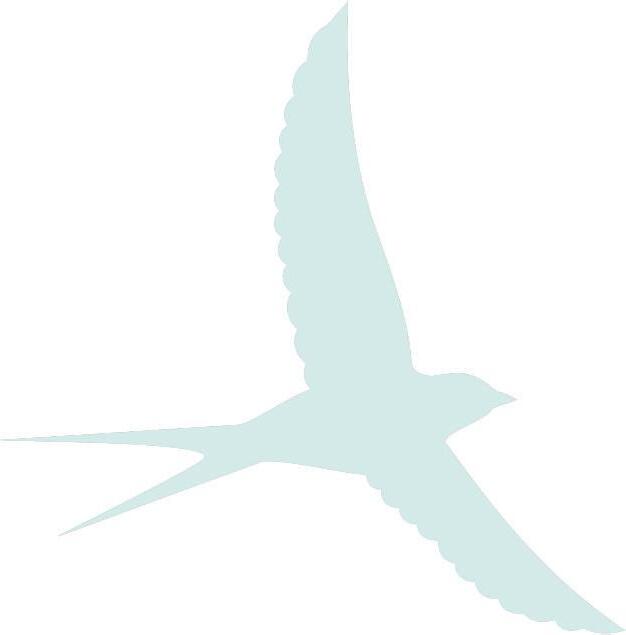
Both swi s and house martins migrate over 3,000 miles each way from Africa to breed in the UK every year.
a heartfelt thank you to everyone who made it a reality. A special thank you goes to Hampshire Ornithological Society for their generous funding, Hampshire Swifts for their expert advice and guidance, and to Peak Boxes for their craftsmanship.
“This tower represents a huge step in our ongoing conservation efforts to protect these vulnerable species, and we couldn’t have achieved it without the support of our partners and the dedication of so many involved.”
Aspecially designed nesting tower has been installed at Blashford Lakes Nature Reserve to support struggling populations of swifts and house martins.
It marks the Trust’s first nesting tower across its estate, providing much-needed secure nesting sites for these red-listed bird species.
Swifts and house martins have experienced significant population declines in recent decades, due to habitat loss and a reduction in suitable nesting sites. The UK breeding population of swifts declined by 66% between 1995 and 2022, while house martins have declined by 44%. They migrate 3,000 miles from sub-Saharan Africa to breed in the UK, depending on suitable nesting sites and an abundant insect population. Historically, swifts have nested in the roofs of older buildings, but modern renovations are sealing up access points, leaving them without suitable breeding spaces.
The new tower, standing five metres tall, features 23 swift boxes and 12 house martin cups, offering much-needed breeding opportunities. It incorporates ventilation to keep the nests cool during warmer months and is equipped with solar panels and speakers to play prerecorded bird calls, attracting young birds searching for a nesting site to settle into. By mimicking its natural nesting conditions and offering a secure, predator-free location, the tower will help the birds to thrive.
The wetlands, reed beds, and woodlands at Blashford Lakes Nature Reserve create perfect conditions for insects to flourish, ensuring the birds have the resources they need to thrive during the breeding season.
Bringing this vision to life required a combination of expert knowledge, skilled design, and generous support, as Jack Medley, Reserves Officer at Blashford Lakes, explains: “I’m incredibly proud of this project and would like to extend


Located next to the site’s largest Lake, Ibsley Water, the tower is viewable near Goosander hide. It will be closely monitored, with data collected on nest occupancy each year.
House martins
• Plump bodies, short, forked tails, broad wings, glossy blue-black upper, with white underparts and white rump
• Length: 12cm Wingspan: 28cm
• See them from April-September
• 2-3 broods per year, each with 4-5 eggs
• The young from an early brood help to feed young of a later brood
Swi s
• Known for their high-speed aerial acrobatics as they hunt on the wing
• Their piercing screeches can be heard during the breeding season
• Short, forked tail, long scythe-shaped wings and sooty brown in colour
• Length: 16cm Wingspan: 44cm
• See them from April-August
• They have 1 brood a year with 2-3 eggs
• Young swi s do press ups to strengthen their wings before their first flight
• Fast fliers reaching up to 70mph
New breeding centre to safeguard threatened crayfish
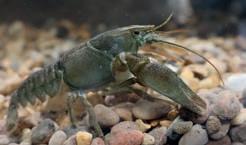
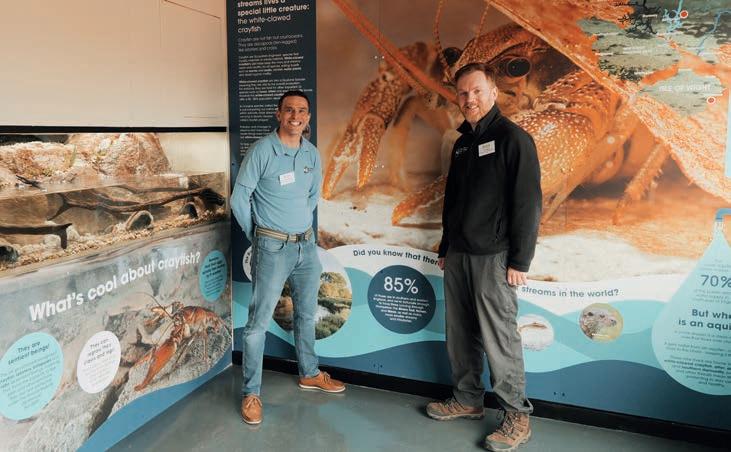
A new Native Species Zone has officially opened at Marwell Zoo, marking a significant step in efforts to safeguard the endangered, white-clawed crayfish Austropotamobius pallipes – Britain’s only native crayfish.
Once abundant in Hampshire’s chalk streams, white-clawed crayfish have suffered a dramatic decline in the past 40 years, primarily due to the introduction of an invasive non-native species, the signal crayfish Pacifastacus leniusculus. This species is larger and outcompetes and predates on our native crayfish, but more devastatingly carries a deadly crayfish plague, which can cause the complete loss of populations of white-clawed crayfish in a matter of weeks.
Developed in partnership with Hampshire & Isle of Wight Wildlife Trust


and Bristol Zoological Society, Marwell’s dedicated breeding centre will play a crucial role in the Southern Chalk Streams Project – an initiative which protects and restores these fragile freshwater ecosystems, with a focus on the endangered, white-clawed crayfish.
The facility, which is the first of its kind in Hampshire, will provide a biosecure haven to rear crayfish before either their release into protected ark sites in Hampshire, or ‘return’ to the river catchment from which their parents were collected.
Dr Ben Rushbrook, Principal Ecologist at the Trust, said: “Through the Southern Chalk Streams Project, and with the help of our partners, we are not just conserving this iconic species, we’re looking to ensure we have healthy and biodiverse chalk rivers for generations to come.”
Salmon on the brink
Atlantic salmon, Salmo salar, are vanishing from the River Itchen. Once common in this rare chalk stream, numbers have collapsed — just 133 returned to spawn in 2022 and only 187 in 2024.
This genetically rare and unique species is a key indicator of the river’s health. The Itchen hasn’t met its conservation target since 2015 and salmon decline signals wider ecological distress. But there’s hope. The Trust has united with partners to

launch the Itchen Salmon Delivery Plan (ISDP), tackling threats like pollution, habitat loss, climate change and water abstraction. The plan will deliver practical action and help restore habitats, improve water quality and involve local communities.
Small actions that you can take include saving water, supporting policy and volunteering. Learn more: hiwwt.org.uk/ news/save-our-salmon.
News in brief
Inspiring new signs at nature reserves
Visitors to our nature reserves will start noticing new signage which is being installed at key points on our sites across both counties. This exciting upgrade is part of a longterm project by the Trust to enhance the visitor experience and highlight the incredible wildlife found at these special sites.
The new signs will not only help people identify and appreciate the wildlife they encounter but also deepen their awareness of the Trust’s vital conservation work. Designed to inspire, they aim to encourage visitors to take action for nature and support a wilder future.
Nature reserves offer a unique opportunity to connect with the natural world, and these upgrades will ensure that every visit is even more rewarding. The Trust hopes that the new signage will enhance enjoyment and appreciation of these beautiful landscapes, reminding us of the importance of protecting them for generations to come.
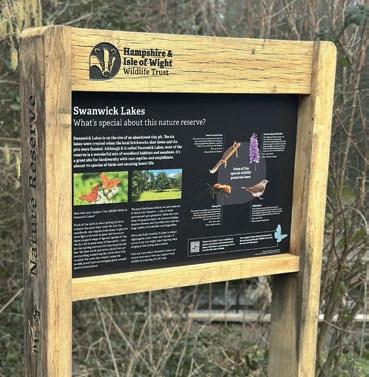
Privacy update
Our Privacy Notice has been updated to reflect how we collect, manage, process and protect individuals’ personal data. It also sets out your data protection rights. To read the updated Privacy Notice, visit hiwwt.org.uk/privacy-notice
Principal Ecologist Dr Ben Rushbrook with Ecologist Tom Selby inside the white-clawed crayfish breeding centre.

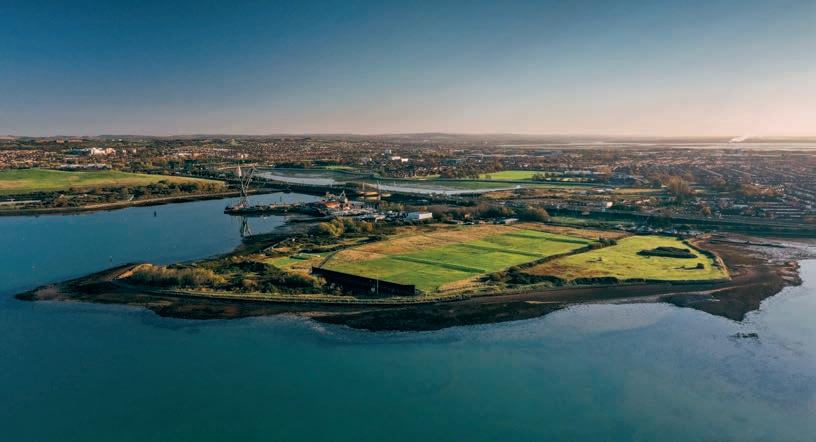
Government revisits destructive Tipner West development
In March, Hampshire & Isle of Wight Wildlife Trust and the RSPB welcomed the opinion given by the Secretary of State for Housing, Communities and Local Government, the Rt Hon Angela Rayner MP, that the need for housing and employment would not out-weigh the importance of upholding legal environmental protections at Tipner West.
This ruling represented a huge victory for wildlife confirming that the benefit of the proposed development to the public does not override the significant ecological damage it would have caused at Tipner West.
The Trust welcomed the Secretary of State’s response and said its ‘new direction’ for Tipner West would bring ‘real
and lasting benefits for communities, the economy, and wildlife,’ while Gemma Cantelo, Head of Policy and Advocacy at RSPB England said the decision was a win for nature and she called for a planning system that delivers the best possible outcome for wildlife and communities.
However - as we printed - plans for the 800-home development have been put back under review by the Government.
Responding to the news that the proposals are being reassessed, Debbie Tann, the Trust’s Chief Executive, said the original refusal was ‘sound’ and said that these ‘irreplaceable habitats must never be called into question again.’
Hampshire & Isle of Wight Wildlife Trust and the RSPB are open to engaging with Portsmouth City Council to explore how a truly nature-positive approach can be taken at Tipner West. We will continue to work with partners, local people, and decision-makers to ensure that Tipner West’s natural value is respected, and its future is shaped in a way that reflects its importance as a protected wildlife site.
For the latest update, please visit: hiwwt.org.uk/tipner
Seagrass returns to the Hamble for the first time in decades
For the first time in nearly a century, seagrass has returned once more to the River Hamble.
On April 10th, Hampshire & Isle of Wight Wildlife Trust planted 2,000 seeds directly into the seabed – marking a hopeful step forward for marine conservation in the Solent. Seagrass, a flowering marine plant, plays a vital role in healthy seas. It provides a nursery for fish, stores carbon, improves water quality, and protects coastlines. But due to pollution, dredging, boat anchoring, disease and coastal development, the UK has lost up to 92% of its seagrass meadows in the past 100 years.
The River Hamble once supported rich eelgrass beds until an outbreak of a wasting disease in the 1930s caused widespread loss.
“This is a huge moment for local marine recovery,” said Ellie Parker, the Trust’s Marine Officer. “To return and plant seeds in waters where we once found nothing feels incredibly hopeful.”
The Trust used a specialist method called Dispenser Injection Seeding to plant the seeds with minimal disturbance. Collected by volunteers in autumn 2024 from beds at Farlington, the seeds were carefully stored at the University of Portsmouth’s Institute of Marine Science over winter before being sown this spring.
The Hamble planting is part of the wider Solent Seascape Project. So far this year,
Tim Ferrero, Senior Specialist in Marine Conservation and Ellie Parker, Marine Officer at the Trust planting seagrass seeds in the River Hamble.
over 58,000 seagrass seeds have been planted by the Trust and volunteers at key sites including Calshot and Seaview. With community support and expert care, these underwater meadows are beginning to return. Find out more: hiwwt.org.uk/news/seagrass-returnsriver-hamble-first-time-decades
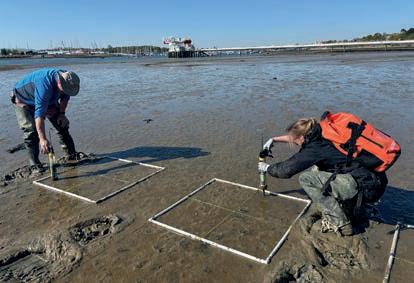
Drone shot of Tipner West.
Right:
Green light for wild beaver release
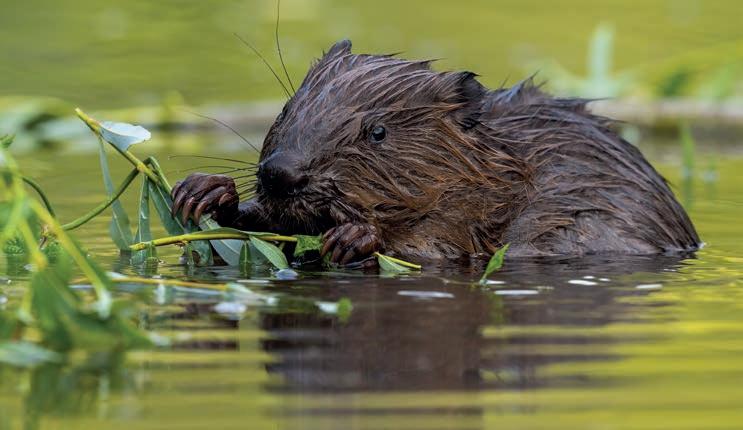
The Trust has welcomed the Government’s decision to legalise the wild release of Eurasian beavers in England. This landmark move acknowledges the substantial ecological and societal benefits that beavers bring to our natural landscapes and communities.
Having historically been hunted to extinction, beavers are reclaiming their rightful place in the English landscape, bringing a wealth of ecological benefits. By building dams, they create wetlands that improve water quality, help regulate water flows, reduce flood risk, and boost biodiversity.
Jamie Marsh, Director of Nature Recovery, Wilder Wight, Solent and Seas, said: “This news is monumental for wildlife and rivers in England. Beavers are a keystone species whose return to our landscapes will have lasting positive impacts on our wetland ecosystems.”
Location identified
The Trust has long recognised the Eastern Yar on the Isle of Wight as a prime location for the wild release of beavers. Artificial straightening of the river, dredging and pollution from sewage discharge plus agricultural runoff has impaired the river’s ability to support diverse wildlife and manage flood risks. As a result, support for nature’s recovery in the Eastern Yar is needed now more than ever.
Beavers can help restore this vital habitat by naturally slowing water flow and creating diverse wetland environments, which support a wide range of plant and animal species.
Our work
Nicola Wheeler, Senior Beaver Recovery Project Officer, said there had been ‘extensive planning’ in the background over five years, engaging with stakeholders, gathering data, conducting analysis and surveys, and assessing the suitability of the landscape.
She said: “This marks significant advancement in our mission to use nature-based solutions for flood management and biodiversity recovery, and we look forward to taking the next steps toward their wild release.”
Looking ahead
Now that the Government has announced it will be allowing some wild releases, the Trust will be increasing engagement and advancing conversations on coexistence with stakeholders and communities. An Expression of Interest has been submitted to Natural England for assessment and feedback, and we hope to be invited to submit a full licence application in the autumn.
For more updates visit hiwwt.org.uk/beaver-news
National recognition for our campaigning leader
The Trust’s Chief Executive, Debbie Tann, has been named one of the UK’s Top 100 Environmental Professionals in the ENDS Report Power List 2025.
The prestigious list honours the most influential figures shaping the UK’s environmental future.
Debbie’s recognition in the campaigner category celebrates her pioneering work on nutrient neutrality – restoring degraded farmland to reduce pollution and support wildlife. Under her leadership, the Trust has become a national leader in tackling nutrient pollution, with projects like Wilder Little Duxmore transforming nature-depleted land into vibrant habitats (turn to page 22 to find out more).
She is also praised for championing the Trust’s Wilder 2030 Strategy, a bold vision for restoring nature across the region.
ENDS Report has previously described Power List honourees as “changemakers, problem-solvers, and revolutionaries.”
“This is not just a personal honour,” Debbie said, “it’s a celebration of everyone working to give nature a louder voice.”
Learn more about the Trust’s nature-based solutions at hiwwt-nbs.co.uk
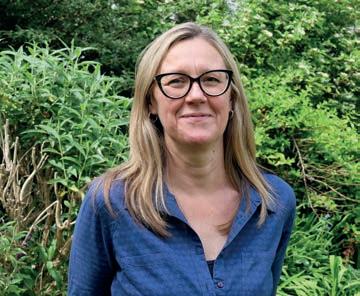
Beaver foraging for food.
5 community projects awarded chalk stream grants
Five inspiring local projects have received funding from the Watercress and Winterbournes Community Grant Scheme, which supports community-led efforts to protect and celebrate the headwaters of the Rivers Test and Itchen.
● Slowing the Flow – Abbotts Ann Primary School
Children explore water topics through rainwater harvesting, a “slow flow” planter, and educational activities.
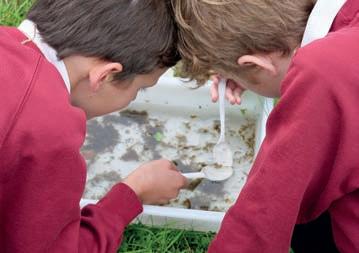
● Pond and Stream Access Path – Laverstoke and Freefolk Millennium Green
A new footpath and signage will connect visitors to the pond and chalk stream, away from the main road.
● Volunteer Engagement – Pillhill Brook Association
Expanded outreach and new monitoring tools will support habitat protection and water quality efforts.
● Particulates in the Upper Itchen – Upper Itchen Restoration CIC Citizen scientists will help study microplastic pollution in partnership with Brighton University.
● Morris Beasts and River Tales –Whitchurch Folk Ltd
Workshops and performances will celebrate the Upper Test through music, crafts, and chalk streaminspired costumes.
Though the grant scheme is now closed, there are still many ways to get involved. Visit hiwwt.org.uk/ watercress-and-winterbournes
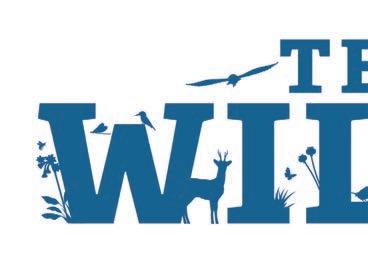
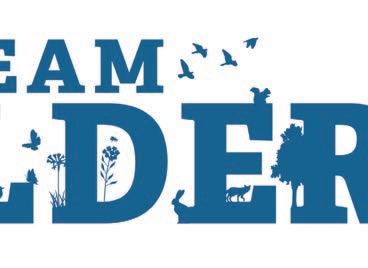

People taking action for nature across our two counties
B-Corps join forces for nature
Companies within the B-Corp network visited Blashford Lakes Nature Reserve to hear about the Trust’s work and how they can play an active role in creating a wilder future.
At the Wild Companions event, guests from B Local Hampshire and Dorset enjoyed a guided walk of the reserve and heard from the Trust’s Chief Executive, Debbie Tann, about the state of nature and the power of community-driven environmental action.
Ian Wadley, Director of Marketing & Fundraising at the Trust, welcomed B-Corps from Hampshire, Dorset, Wiltshire and Surrey, and said: “Companies have a critical role to play in nature’s recovery. We are grateful to have an excellent network of corporate members and partners, and we urge more businesses to urgently commit to making a positive impact on local wildlife
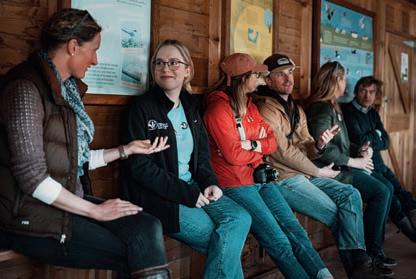
as we battle the many threats facing the natural world.”
Jaimie Harris, co-chair of B Local Hampshire and Dorset, said the purpose of the B-Corp movement is to drive positive change through business, adding: “There must be a relationship between nature and business for a thriving future and, through collaboration, the ripple effect of positivity will be much greater.”
Seagrass supporters boost funding
Boskalis Westminster, the first-ever partner of the Solent Seagrass Restoration project, has extended its funding for another two years, increasing its annual contribution by 50% — from £30,000 to £45,000.
Jenny Burns, Marine Nature Recovery Manager at the Trust, said the renewed support will allow the team to refine planting techniques, scale up restoration efforts, and progress toward a “wilder Solent by 2030.”
“I’m thrilled by Boskalis’s continued commitment,” she added. “Restoring seagrass boosts biodiversity, supports sustainable fisheries, improves water quality, and helps tackle climate change.”

Boskalis Managing Director, Paul de Jong, said: “We’re proud to support this vital marine project. Our investment reflects not just corporate responsibility, but the personal passion our employees have for protecting their local seas.”
Super Champions to play role in future of wildlife
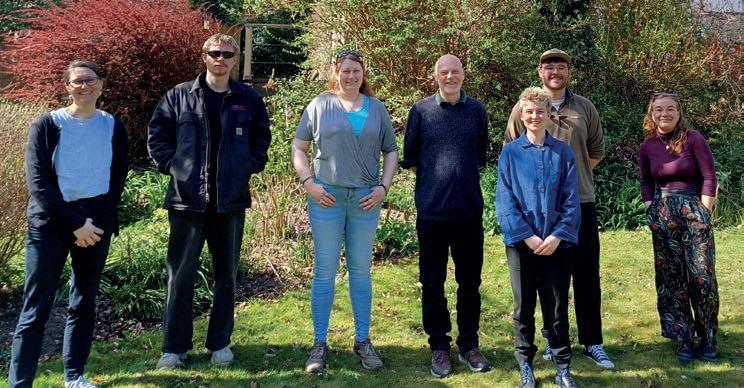

A new enthusiastic and dedicated group of Community Super Champions have been chosen by the Trust to bring people together to tackle climate change and protect the future of wildlife. By fostering community support to take action for nature, they will create more spaces for wildlife, and promote opportunities for people and schools, to connect with nature.
We look forward to hearing more about their great work in future editions, but in the meantime, read on for more about our rewilding Super Champion, artist and sculptor, James Hewins, in our spotlight feature below.
Bringing abundance and biodiversity to Southampton
Southampton-based sculptor and rewilder James Hewins leads on a project, Caustic Bloom, which aims to transform the city’s grass verges into abundant wildflowers, enhancing local biodiversity.
His initiative integrates art, science, and community engagement into the rewilding process. As part of his new ‘super champion’ role created by the Trust, James’s next goal is to engage with a wider audience to inspire more people to make their communities wilder.
James grew up in Dronfield, near Sheffield, with woodland, space and greenery all around him. When he moved south to study sculpture at Winchester School of Art, there were nature reserves and green spaces to escape to, but at his art studio in Old Northam Road in
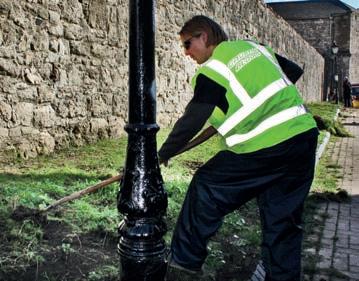
inner city Southampton, he noticed that much of the council-owned land was left abandoned.
“I took nature for granted when I was around it so much,” explains James, “But when I came to Southampton there wasn’t much here, and I wanted to change that.”
The council agreed that James could maintain the verges in his area on their behalf – the start of his conservation installation. He began sowing wildflower seeds, first removing the turf, taking the sites back to bare soil to stop the grass from spreading and choking the flowers.
Within two to three months the verges were blooming with a vibrant mix of perennials and annuals.
“I wanted to change these areas because nothing was being done with
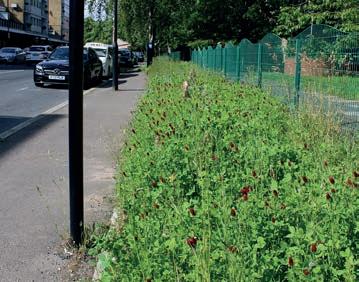

them, they were left derelict. When I started planting, I saw what a huge difference it made to people locally.”
In the future, James would like to carry out species surveys on the rewilded verges to measure the levels of biodiversity. In the meantime, he has created macro-photos of bumblebees, which clearly show the pollen sacks on their legs laden with nectar. “Full sacks represent a healthy amount of food sources in the area,” James explains.
Cabin crew
Aviva’s Group Executive Committee joined a volunteering day at Hook Common Nature Reserve, hosted by Trust Chief Executive Debbie Tann and Reserves Officer Tom Hilder. Together, they built ‘log cabins’ to protect newly cut hazel coppice from deer.
Aviva is a long-term supporter of The Wildlife Trusts, including a £38m donation helping restore UK temperate rainforests.
• For corporate support opportunities: corporates@hiwwt.org.uk
L to R Super Champions: Mathilde Chanvin, James Hewins, Rowena Cowton, Ian Creasey, Jamie March (in front), Theo Vickers and Becky Noakes.
A word from our CEO
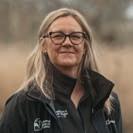
“It feels like an unsettled and difficult time. Nature is being cast as a barrier to progress, a blocker of growth. Recent rhetoric from the government blaming bats and newts for the housing crisis has been deeply worrying. But we know better. We know that true prosperity cannot come at the expense of the natural world.
With less than five years to 2030 –the milestone year when the world has pledged to halt biodiversity loss and begin to restore our ecosystems – the urgency of our work at the Wildlife Trust grows ever clearer.
This year marks my 27th with the Trust, and it’s been a time of deep reflection. Legacy, responsibility, and the long arc of nature’s recovery weigh heavily – but also powerfully – in my thoughts. What we do today will echo long into the future. Every decision, every piece of habitat restored,
every child we help to connect with nature, adds to the mosaic of recovery we are building together.
And we are not alone in this. Last month, I watched Sir David Attenborough’s new film Ocean. Poignant and stirring, it was a timely reminder of the devastating damage we are doing to our world – and the hope that still remains if we allow it to recover. On his 99th birthday, he once again called on us all with clarity and compassion, urging action through the proper protection of 30% of land and sea for nature, with rewilding at its heart – a theme that resonates deeply with our work here in Hampshire and the Isle of Wight.
As I look ahead to our own strategic refresh, I know we need to make a more compelling case for nature as a vital component of our economy. Without healthy nature, our security and resilience as a country is undermined and our wellbeing is compromised.
Our new strategy will emphasise the importance of nature recovery and rewilding for food security, climate resilience, public health and economic success, and it will bring more focus to our role as champions, advocates, influencers and partners to help us build
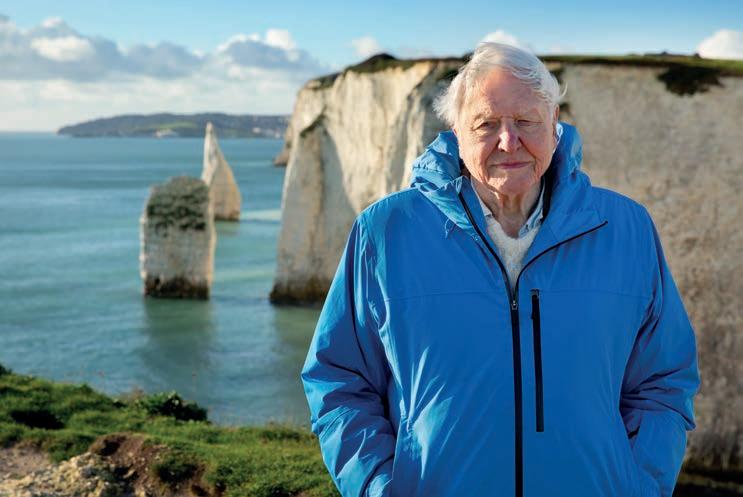
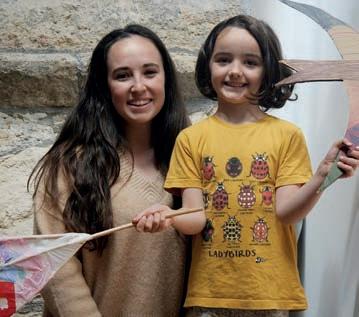
“Every decision, every piece of habitat restored, every child we help to connect with nature, adds to the mosaic of recovery we are building together.”
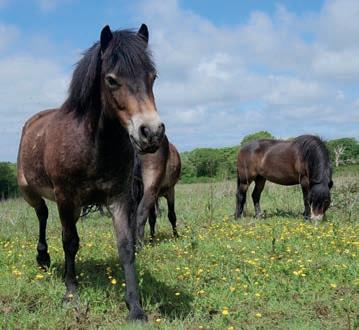
more impact across sectors. We have not won the argument yet, but we must find new and convincing ways of doing so.
Protecting, restoring and rewilding nature isn’t just a project. It’s a principle, a responsibility, a lifelong mission. With your continued support, we can tip the balance. For wildlife. For wild places. For future generations. And for the legacy we will one day leave behind.

Debbie
“
Tann MBE, Chief Executive Debbie Tann MBE
Debbie Tann MBE Hampshire & Isle of Wight Wildlife Trust Chief Executive, shares her views on the region’s most urgent nature and climate challenges.
Ocean with David Attenborough, by Silverback Films and Open Planet Studios, highlights the vital, achievable actions the world can take to restore the ocean and stabilise the climate.
AGM 2025
Notice of the 64th Annual General Meeting of Hampshire & Isle of Wight Wildlife Trust
Thursday 23 October 2025
9.45am - 11.15am
The Point Theatre, 14 Leigh Rd, Eastleigh, SO50 9DE
Dear Members,
I am delighted to invite you to join us in person for our 2025 AGM on Thursday 23 October. This year’s meeting will be held ahead of our Wilder Conference and Awards on the same day (see the back page for information).

Our agenda starts at 9.45am and finishes at 11.15am.
As well as the formal AGM business and votes on resolutions, the meeting will include:
l Members’ questions
l Presentation of the Outstanding Contribution Award
l The chance to meet Trust members and supporters, Trustees and staff
We look forward to seeing you there.
If you are unable to attend, we encourage you to participate by requesting and casting a proxy vote on the formal business and resolutions.
David Jordan OBE, Chairman
* Details of the candidates standing for Trustee election and re-election can be viewed on our website at hiwwt.org.uk/agm
This information can also be requested from the Trust’s office via email agm@hiwwt.org.uk or telephone 01489 774400.
Questions about the AGM?
Email us at agm@hiwwt.org.uk or call 01489 774400
Agenda
Welcome by the Trust’s Chief Executive
Annual General Meeting
1. Opening address by the Trust’s President
2. Apologies for absence
3. Approval of the Minutes of the 63rd Annual General Meeting
4. Report of the Trust’s Chairman on the year 2024–2025
5. Report of the Trust’s Honorary Treasurer on the year 2024–2025 and approval of accounts for the year ended 31 March 2025
6. Appointment of Auditors – Saffery LLP being eligible offer themselves for re-appointment
7. Elections to Council*
Members’ Questions
Presentation of the Outstanding Contribution Award
l Recognises people for their exceptional contributions and significant impact l Honours those who have gone above and beyond in their efforts to support our mission
To register to a end the AGM
Please book your place online now by visiting hiwwt.org.uk/agm
Places are limited and must be booked in advance by Sunday 19 October. If the meeting becomes fully booked before this date, we will close the bookings earlier. The AGM business papers will be available on arrival. They will also be available to view online and download from Thursday 25 September, via hiwwt.org.uk/agm
If you are unable to a end the AGM
You are very welcome to participate by voting on the formal AGM business and resolutions via a postal or online proxy vote. If you would like to register for a proxy vote, please visit hiwwt.org.uk/proxy or call us on 01489 774400 or email us at agm@hiwwt.org.uk and provide your name and address (including postcode). The deadline for requesting a proxy vote is Tuesday 23 September
We will record the AGM so you can catch up on the proceedings after the meeting. We will post edited highlights on our website in November at hiwwt.org.uk/agm
WORDS SARA MILLS Editor, Wild Life magazine
Sara discovers how rewilding can help revive nature—and reconnect us with it.

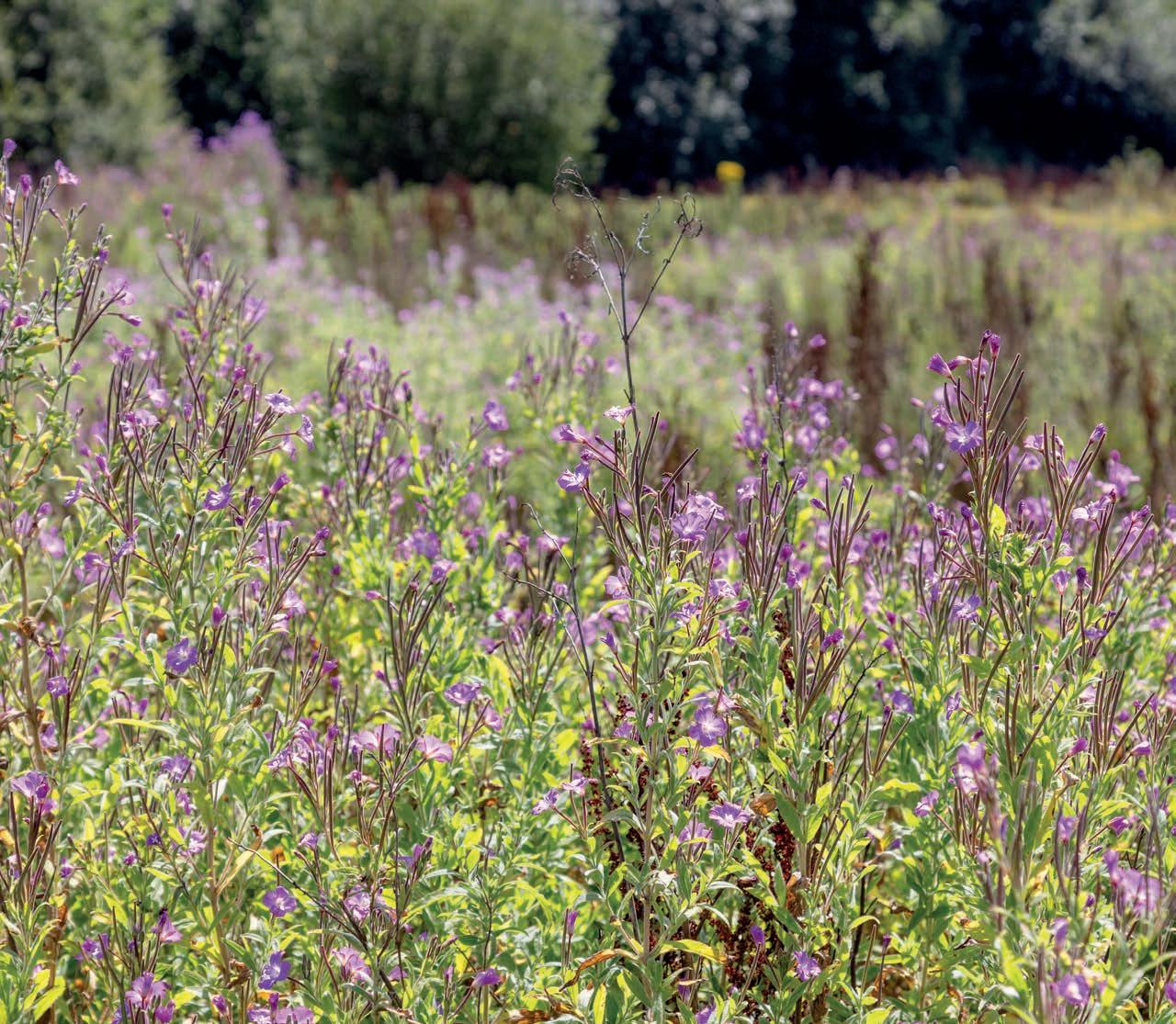
Wild awakening
With over half of the UK’s species in decline, rewilding offers a practical path to restoring wildlife and landscapes across our two counties and beyond.
Human activity is putting nature in crisis. But rewilding has the potential to reverse ecological damage and species loss on a landscape scale, bringing vital benefits for both nature and society.
At its core, rewilding is about giving nature a chance to breathe. It is an attempt to reconnect and reset damaged ecosystems, reverse species loss and
enable biodiversity to return and flourish. It involves reinstating natural processes and reintroducing key species, allowing ecosystems to function more freely with minimal human input.
While the goal is to let nature lead, some management is often still required, particularly in the early stages or where landscapes have lost critical components. Methods may include reintroducing
native species (such as beavers to restore wetlands) or managing herbivores to shape the landscape, allowing rivers to meander naturally creating wetlands and floodplains providing a rich habitat for wildlife, allowing plants to re-establish at their own pace and letting woodland regenerate naturally.
Why rewild?
It can enrich our lives and help us connect with wild nature, while also strengthening climate resilience, and supporting cleaner water, air and healthier soils, providing a sustainable future for
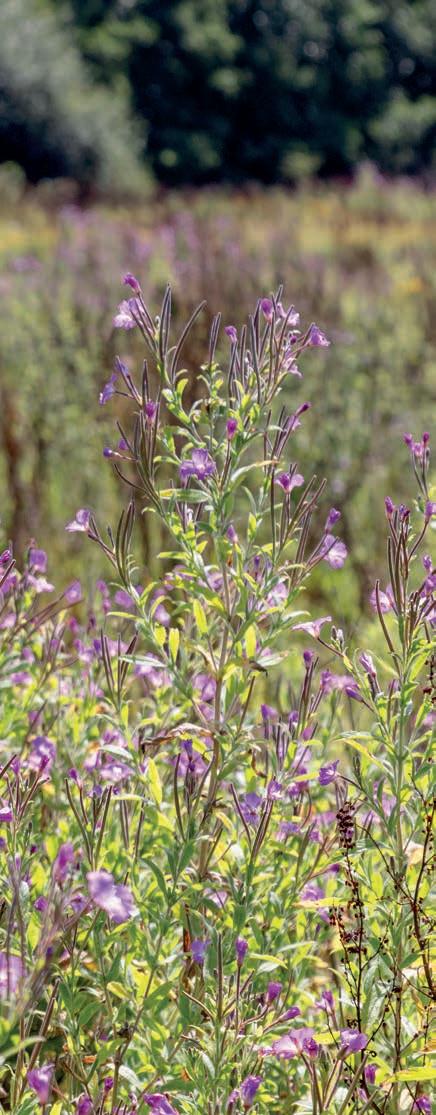
local and wider communities.
In an ever-changing world, the Trust is constantly adapting to and seizing new opportunities to facilitate nature’s recovery. There are a range of options, but essentially rewilding comes down to finding resources to acquire land at scale either directly or working in partnership. We have worked to secure funding to purchase sites for rewilding, taking low grade, intensively managed land and returning it to nature. The Trust has also expanded its existing estate, increasing the size of its reserves and connecting sites. Sometimes these things can be quick, or take decades, but the drive is always there to do more.
Rewilding and farming
With wild bees and hoverflies declining by a third in the UK alone, and with more than 75% of global food crops relying on pollinators to produce crops, we need functioning ecosystems to support our pollinators, improve soil health and build climate resilience to support food production.
For farmers, or businesses that manage land, rewilding can be seen as a controversial concept. The approach of returning land to nature can be seen as competition or a waste of land that could otherwise be producing food, energy crops or fibre. Amid concerns over
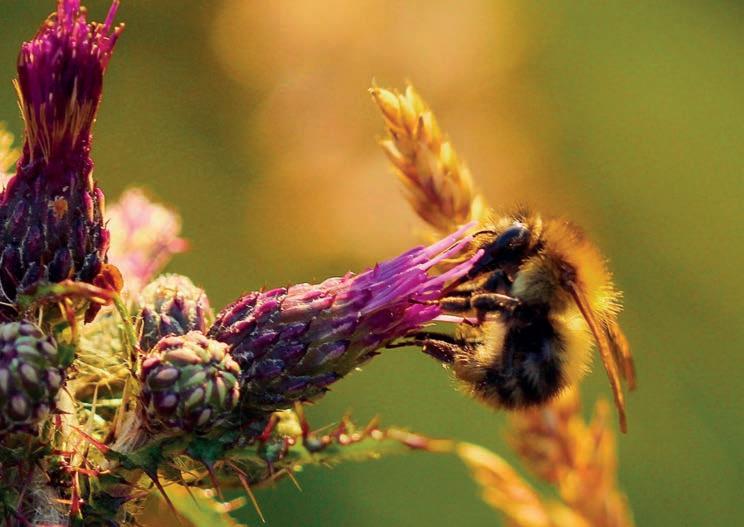
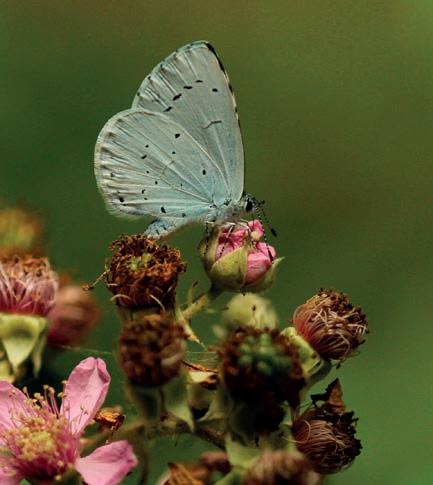
economic uncertainty within the sector this is not a surprise, but we cannot escape the impact modern agriculture has had on our environment. Current methods of food production are not sustainable and a farming transition to regenerative practice is urgently needed. Rewilding marginal areas of land alongside productive systems can be highly beneficial to farming and so the two need to work together.
Where land is highly productive and of high agricultural value then food production should be the priority but in a way that protects and enhances wildlife too. Where land is of low agricultural value (so-called marginal land) this is often best given back to nature to provide all of those ecosystem services we need: carbon capture, water retention, flood and drought resilience, space for nature, pollinators, healthy soils, all of which are vital to us.
Leading rewilding charity (and Trust partner) Rewilding Britain says that the practice ‘offers hope’, helping landowners to adapt to climate change and navigate an uncertain future by providing alternative sources of income and aligning with nature-friendly practices. Many estates have found ways of incorporating both rewilding and food production into their businesses, and a Rewilding Britain report on their website found that more jobs were created as a result.
Jamie Marsh, Director of Nature Recovery, Wilder Wight, Solent and Seas, says a shift in culture is needed to encourage more landowners to restore
Left: Wild meadow at Wilder Little Duxmore.
their land. “One of the biggest barriers with rewilding is getting over the loss of productive land. People think that you can only do one thing [rewilding] or another [farming] – it’s either land that’s being abandoned or land that’s being productive, but the two can coexist. Ours is a more natural system that is much better for the environment. In fact, it’s about restoring the ecosystem function, which is integral to farming itself.”
Solutions
Arcadian Ecology, the Trust’s in-house consultancy, offers practical land management and ecology solutions to businesses and landowners, including innovative ways to rewild. Stopping intensive farming on a site, for example, reduces nitrates in the soil, which reduces the runoff of chemicals into our rivers and seas and allows the time and space for the land to recover naturally, restoring ecological function and improving soil health and water quality.
Nature-based solutions can provide landowners with economic opportunities, such as Biodiversity Net Gain, nutrient credit trading, or funding through grant schemes like the Sustainable Farming Incentive (SFI) and Environmental Stewardship.
Here’s a closer look at some ways to rewild:
Conservation grazing
The conservation grazing programme is one of the Trust’s primary tools for rewilding. We use different animals including cows, sheep, ponies (even goats!). Without grazing, the alternative management options would be cutting and mowing, which are both expensive and worse for the environment. For more about grazing, turn to page 24
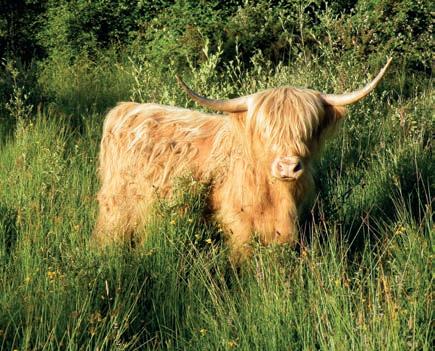
Goats from The Garlic Farm, Isle of Wight grazing Knighton Down Nature Reserve, demonstrating how farming and nature can work alongside each other.
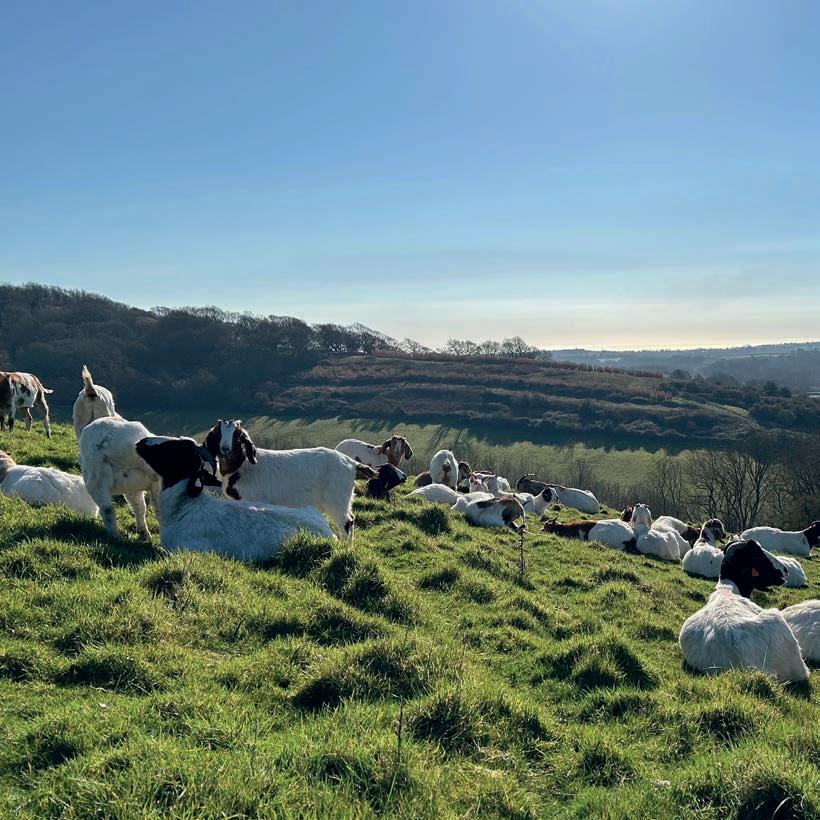
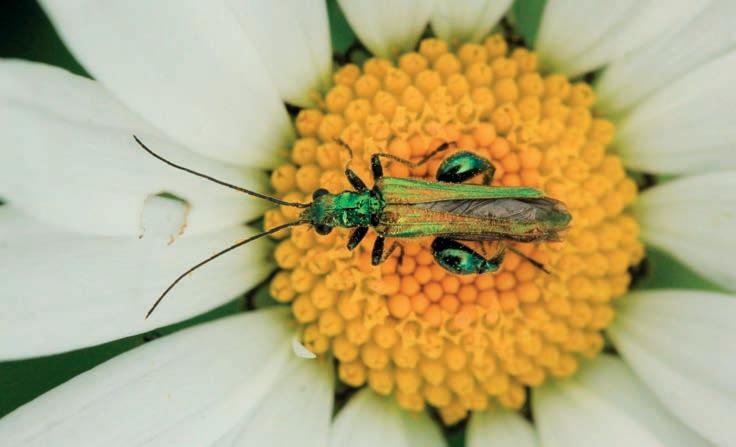
Working with water
Healthy water systems play a crucial role in biodiversity, flood management and climate resilience. By allowing restoration of natural systems, we can reconnect rivers, floodplains and wetlandsimproving water quality, filtering pollutants, and creating new habitats for fish, amphibians, invertebrates, and birds. Rewilding can improve flood resilience and reduce the risk of damage during heavy rainfall, reduce pollutants and in turn protect coastal habitats that, in return, provide a whole range of
ecosystem services helping filter excess nutrients, protect coastal ecosystems from erosion and provide climate resilience.
Engaging people
Hampshire & Isle of Wight Rewilding Network aims to bring together landowners of 40 hectares or more (99 acres) across our two counties, building momentum for rewilding and ecological restoration. By sharing learning and expertise and providing access to specialist knowledge and comprehensive
Thick-legged flower beetle
Highland cattle at Emer Bog.
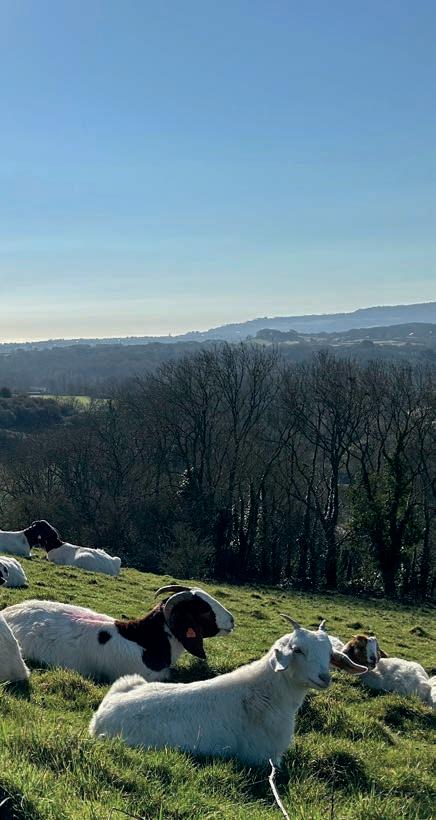
Nature is messy, it should be diverse. It thrives in what we o en perceive as chaos and mess, scrub, ‘weeds’ and dead trees. It should be all things and everything.
Do you have land you’d like to rewild? Here are our top tips:
• In the first year of rewilding a site, it’s best to do nothing - let natural processes begin.
• Spend a year observing the site. This will help you identify existing plants and shrubs; patience is key at this stage.
• During this time, assess the land’s characteristics - soil type, landscape features, and more. Use this information to create a plan.
• Next, seek expert advice. We recommend joining Hampshire and Isle of Wight Rewilding Network. Visit hiwwt.org.uk/rewilding-network for details.
ecological and environmental monitoring, the benefits for nature can be evidenced, inspiring other landowners to support nature through rewilding on their estates.
Grass roots projects
Rewilding doesn’t just apply to rural areas. In Mansbridge, on the north-east side of Southampton, a partnership between the Trust and local housing association Abri set out to make the estate wilder, greener and more connected. Abri, residents and members of the Trust worked collectively on two new wildflower areas, one in the Memorial Garden on Mansbridge Road and another on the Howard Close slope. The Abri Grounds Management Team removed turf and topsoil before sowing wildflower seed to create a riot of colour
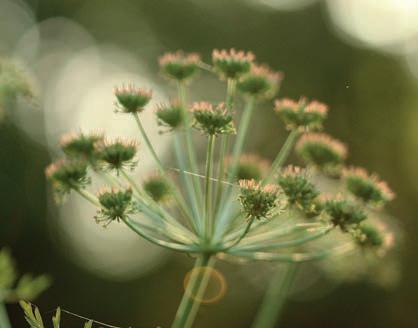
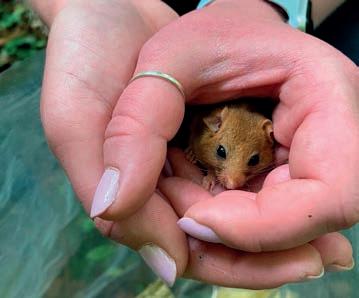
and food for nature. Creativity and community spirit have already taken root here and our thanks go to Jill Doubleday, Community Engagement Officer and Dawn O’Malley, Senior Engagement Manager, both from the Trust, for inspiring this movement.
In Old Northam Road in inner city Southampton, rewilder James Hewins has been recognised by the Trust for rewilding over 2,000 square metres of council verges into abundant wildflowers with his Caustic Bloom project (p15). Recently recruited as a super champion for the Trust, James said: “Unless you show people that there is a different way, things stay the same. When you start growing wildflowers, people say they like what you are doing, but no one
goes up to the council worker cutting the grass and says ‘I love what you’re doing’ because no one is interested. They are more interested in wild areas – they just need to be shown what it could look like.”
Historical perspective and shifting opinion
Jamie Marsh agrees that education is key: “As a society we are obsessed with nature being neat and manicured. We drive through the countryside, through landscapes of bright green fields and squared off hedges and we have come to accept this as ‘the norm’. But it isn’t.
“Nature is messy, it should be diverse. It thrives in what we often perceive as chaos and mess, scrub, ’weeds‘ and dead trees. It should be all things and everything. There is still more than enough space for wildness, we need to embrace it, as it holds many of the solutions to the problems we face.”
Thank you to all our supporters who have made it possible to buy land, invest in community engagement, and provide funds to help manage the land. You have made such a big contribution towards making our two counties wilder, more connected, healthier and more productive. To find out how rewilding has worked on the Isle of Wight, turn to page 22
How you can help at home
For ways to support wildlife in your own outdoor space, go to page 28 to read tips from our Garden Champions.
Hazel dormouse
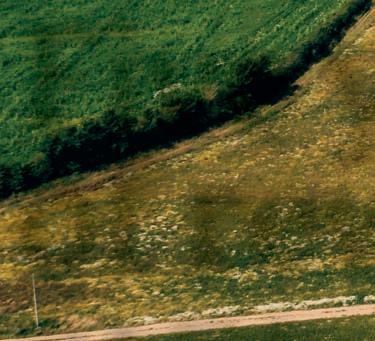
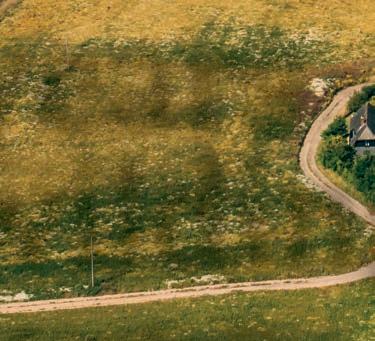
Five years of rewilding at Wilder Li le Duxmore
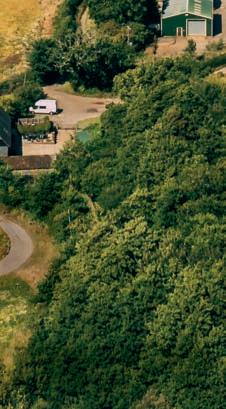
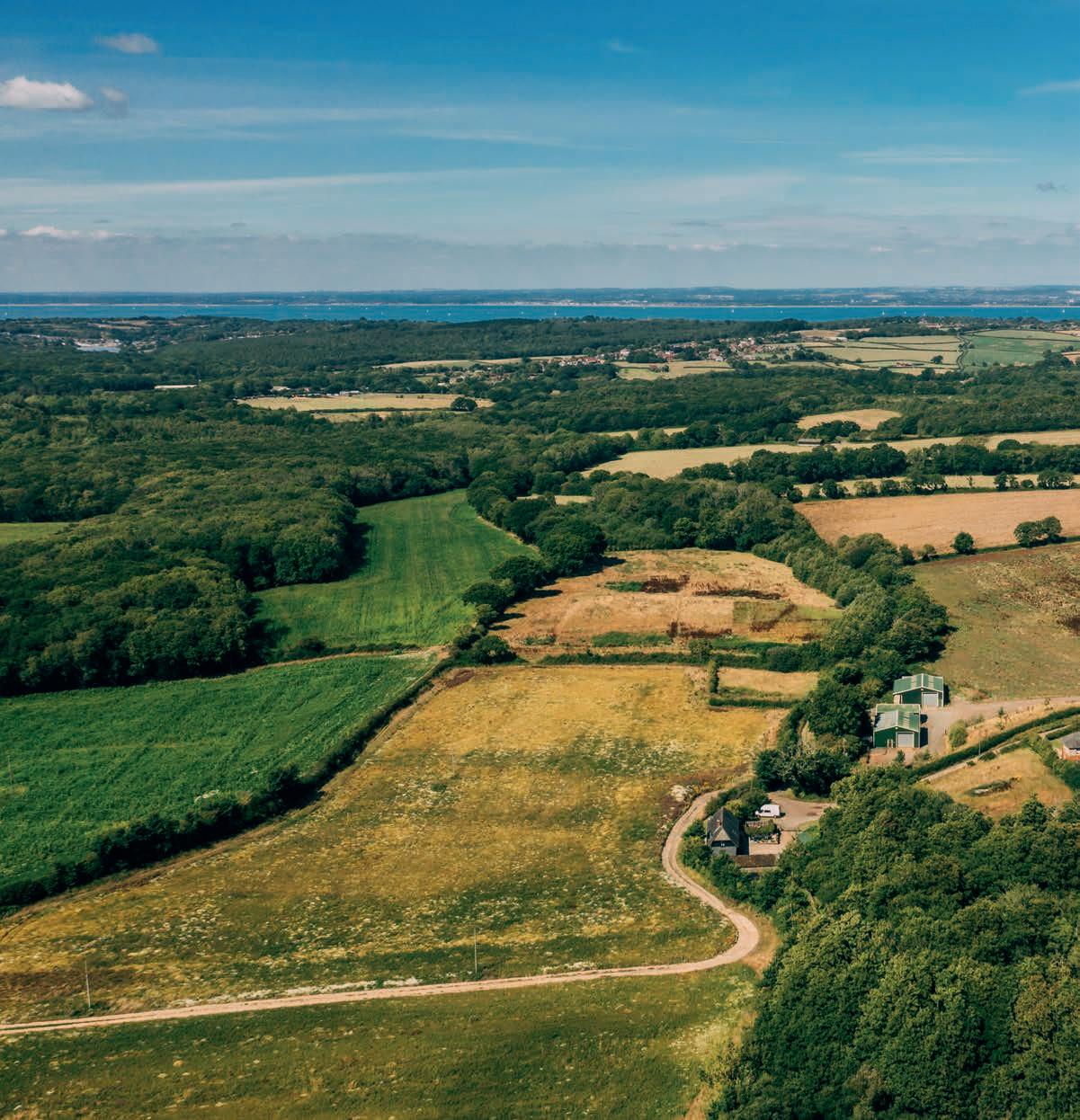
Back in 2020, Little Duxmore Farm was a barren, degraded landscape. Neat hedges bordered uniform arable fields, and the landscape was eerily quiet, with limited wildlife. It was a sad, lifeless place.
Fast forward five years, and Wilder Little Duxmore has transformed into a vibrant landscape where wildlife is
thriving year on year.
From the vivid green flash of woodpeckers darting through trees, to the screeching calls of barn owls at dusk, kestrels swooping for prey, the summer hum of invertebrates, and the melodious song of skylarks, great tits, starlings, and blackcaps – life has returned.
Beginning of the journey
In 2020, the Trust purchased its first rewilding site: Little Duxmore Farm. This 42-hectare (104-acre) arable farm had been intensively managed, receiving high levels of fertiliser inputs. By taking on ownership and management of the site, we took this land out of intensive arable production.
WORDS KATE GARNHAM Senior Communications Officer
Kate is passionate about people and nature, and her mission is to spread the word that working collectively helps restore nature at scale.

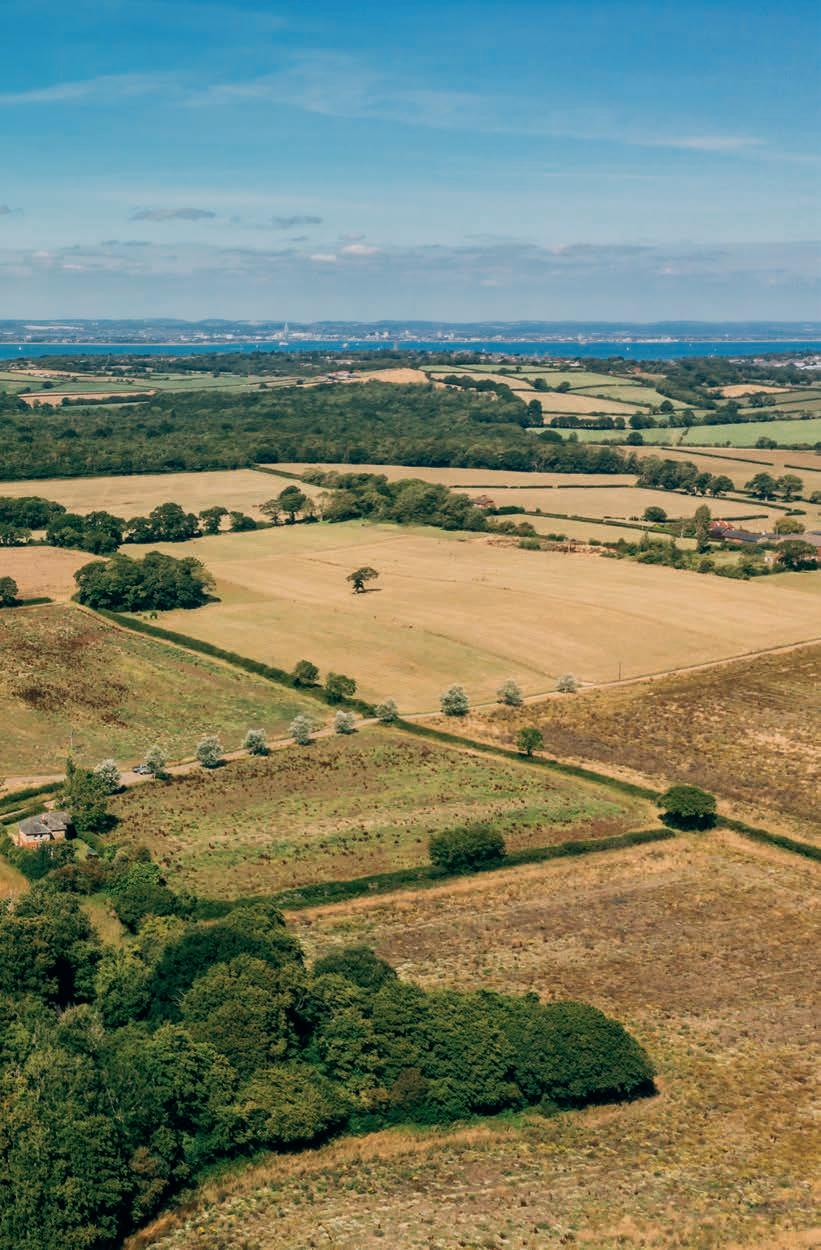
Fertiliser inputs used in agriculture farming, along with sewage and industrial processes, all damage our natural environment through excessive nutrients entering our rivers and seas. Nutrient loading in watercourses around the Solent causes algal blooms, which severely impact marine habitats such as seagrass meadows – vital ecosystems for
marine life including bass, cuttlefish, and seahorses.
Our aim when taking on Little Duxmore Farm was clear: to cease all intensive farming, stop nutrient pollution entering the Solent by eliminating fertiliser use, and step back to allow the land to recover and rewild. With that Wilder Little Duxmore was born – a sanctuary for wildlife, protected for nature in perpetuity.
What’s happening now
Since 2020, we have stepped back and allowed nature to reclaim the land. Our Isle of Wight estates team have worked hard over the past few years to install the perimeter fencing to enable grazing animals to roam freely across the site’s habitats. Beyond this, we’ve taken a hands-off approach – letting nature lead. So far, the only management tool we’ve used is grazing animals, and they do an incredible job. In time, we hope to support the process of rewilding through sensitive management, such as blocking drainage ditches to re-wet the site.
It’s incredible to see just how quickly nature can bounce back when given the time and space to heal. Through arable reversion and grazing, we’ve seen the return of rich arable flora, scrub, and woodland creating a much wilder landscape. As common species return, rarities follow – which have included species such as hen harriers, wall butterflies, and weasels to date.
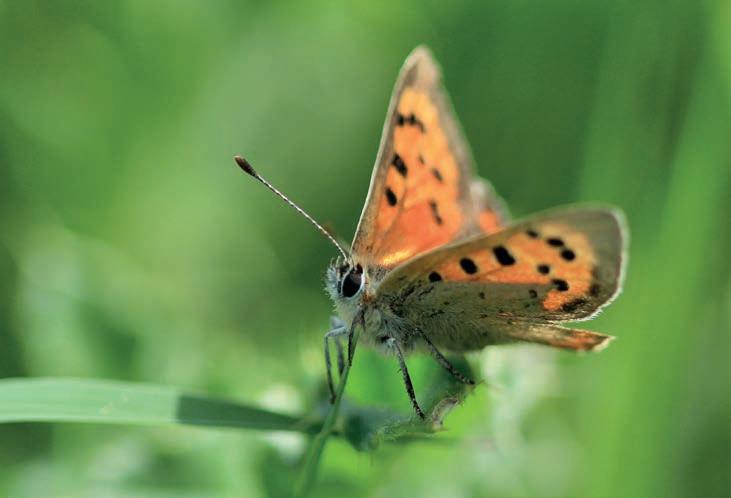
Small copper at Wilder Little Duxmore.
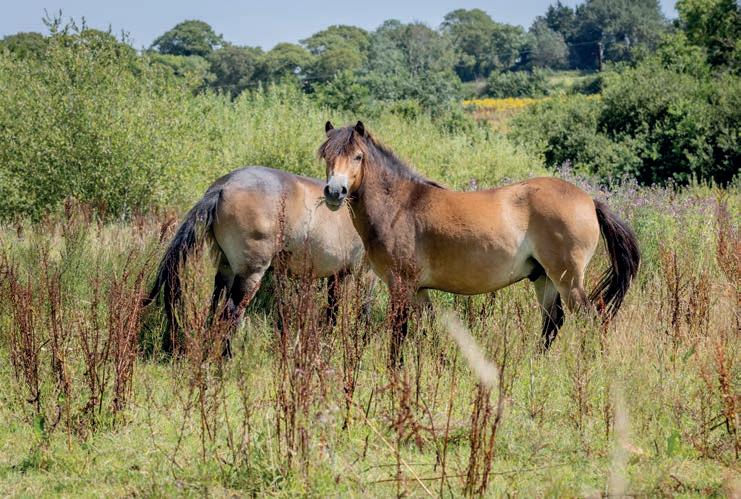
Grazing
In the UK, we have lost many of our key species, free roaming grazing animals such as bison and aurochs and the key predator species such as wolves, bears and lynx. As such, we replicate their ecological role through appropriate grazing regimes to mimic natural herbivore movement.
In 2023, we introduced a small herd of Exmoor ponies to create structural diversity in the vegetation, fostering a range of habitat niches. It’s exhilarating to see the Exmoors galloping across the land, their manes flowing in the wind. Watching their sleek summer coats transition to thick, fluffy winter ones is a beautiful marker of the changing seasons.
Alongside our resident Exmoor ponies, we work with Nunwell Home Farm and other local graziers to bring in rare breed cows and pigs to ‘farm with wildlife’. Each species contributes differently to the landscape: pigs rootle and create ground disturbances that form wallows and scrapes, ideal for species like diving beetles. Cows, meanwhile, use their tongues to wrap around grass and pull it, unlike other grazers that bite, leading to unique grazing patterns.
These different grazing behaviours create a structurally diverse landscape. When animals are allowed to graze freely, they select different plants, and even different parts of the plant, to nibble or browse. Over time, this selective eating by the animals creates a varied structure within the plants and the habitat. It is this that helps create the right conditions for a wide range of insects, birds, reptiles, mammals, and plants to exist.
Ecological monitoring
Monitoring is a vital part of rewilding. We implement a comprehensive ecological and environmental monitoring programme using robust data collection methods to:
l Track project progress and success l Inform site-specific management l Record and share conservation outcomes We carry out a wide range of surveys, including bird, bat, small mammal, earthworm, dung beetle, and pollinator monitoring. We also conduct soil testing and fixed-point photography. And the results have been remarkable! Since beginning the monitoring in 2021, we have seen:
l 19 new bird species on site (bringing the total number of recorded bird species to 58 since 2021). Highlights include woodcock wintering on site, high breeding numbers of whitethroat and wren, merlin and goshawk hunting in winter, and scarce migrants like tree pipits and wheatears
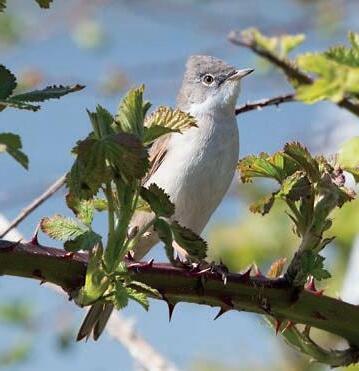
feeding. Bird counts rose by 49.5% between 2021 and 2024
l 28 butterfly species recorded from 2021 to 2024, including two vulnerable species (chalk hill blue and small heath) and two endangered species (Glanville fritillary and wall butterfly).
l Earthworm populations have grown since 2021. So far, 14 species have been recorded. Our monitoring has shed light on the critical relationship between land use and soil health: excessive phosphorus (from fertilisers) correlates with fewer earthworms, while excessive nitrates impact surface-dwelling worm species – harming biodiversity, water quality, and carbon storage.
Below: Different species of earthworms surveyed in trays.
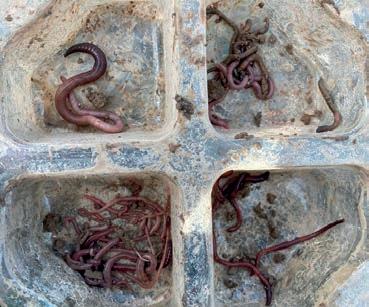
Aggie Thompson, Nature-based Solutions Officer at the Trust, says: “Soil is the foundation of any ecosystem and is one of the first steps to ecosystem restoration, whilst earthworms are the ecosystem engineers of soil.
“They improve soil structure by creating pores which allow for the flow of water and gasses, cycle nutrients and organic matter, which increases the bacterial and fungal presence in soil and break down environmental pollutants.
“A healthy and species diverse earthworm population leads to reduced soil erosion, increased flooding resilience, fewer environmental pollutants, and increased availability of nutrients in the soil for plants.
“Having healthy soil and restoring natural soil processes is one of the first steps to restoring an ecosystem.”
Exmoor ponies
Whitethroat
What’s next?
The transformation over the past five years has been extraordinary. Wildlife is returning, and ecosystems are rebuilding. It’s a real privilege to witness the regeneration and work from this amazing place.
The rapid pace of recovery highlights the power of nature. It also showcases how food production can coexist with nature, through collaboration with farmers and graziers like Nunwell Home Farm who share our ethos. By working in harmony with nature, we can support both people and wildlife. When animals and people work together, the results are remarkable – as demonstrated by our ecological outcomes.
While our approach at Wilder Little Duxmore has largely been to step back
l Soil health is improving. Since 2021, there has been a 32.6% mean decrease of soil mineral nitrogen across the site, reducing the runoff into our watercourses and therefore reducing the amount of pollution entering in the Solent. With no chemical inputs, soil structure and water retention have improved, boosting greater biodiversity and carbon storage.
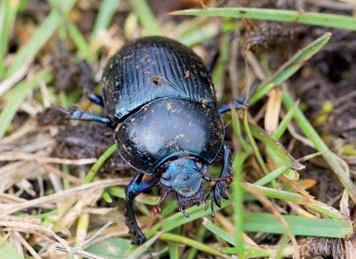
l Twelve dung beetle species recorded, including one nationally scarce species, Onthophagus medius, and one near threatened species, Plagiogonus arenarius
l Fixed point photography has been taken at different locations across the site since the beginning of Wilder Little Duxmore’s rewilding journey. This is a fantastic way to visually document and monitor the landscape changes over time. Looking back from the start to now shows the remarkable change in landscape and visually shows why the landscape today is supporting a huge array of species.
and let nature take the lead, there are occasions where a small intervention can create big ecological benefits. One of these is the creation of a few ponds across the site. When pigs have been present, they’ve instinctively located underground springs and created natural wallows and scrapes – showing just how in tune animals are with the landscape. Inspired by this, our estates team is planning to establish ponds to further enhance habitat diversity, supporting amphibians, invertebrates, birds, and bats.
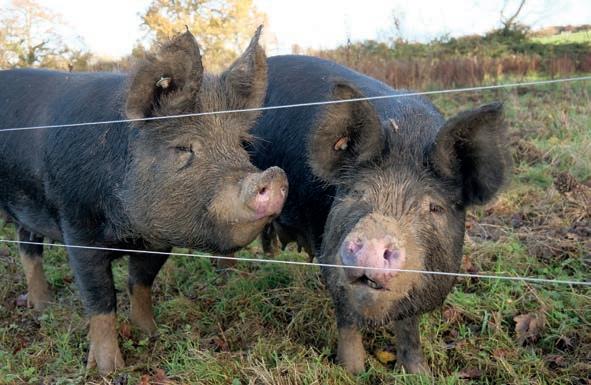
We’re excited to see what the next five years will bring as Wilder Little Duxmore continues to flourish, become even richer in wildlife and, overall, wilder!
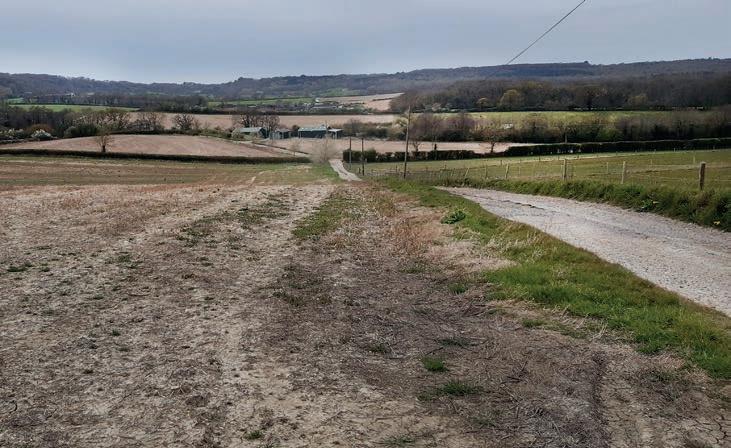
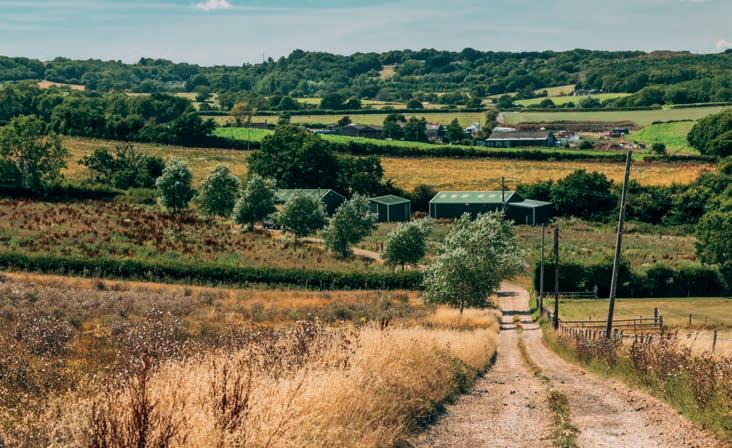
April 2020
July 2024
Dung beetle
Nunwell Home Farm Berkshire pigs grazing at Wilder Little Duxmore.
KATE
GARNHAM

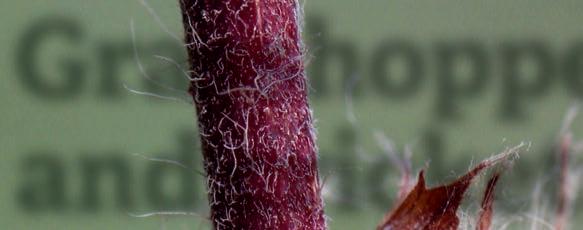
Grasshoppers and crickets 6 places to hear

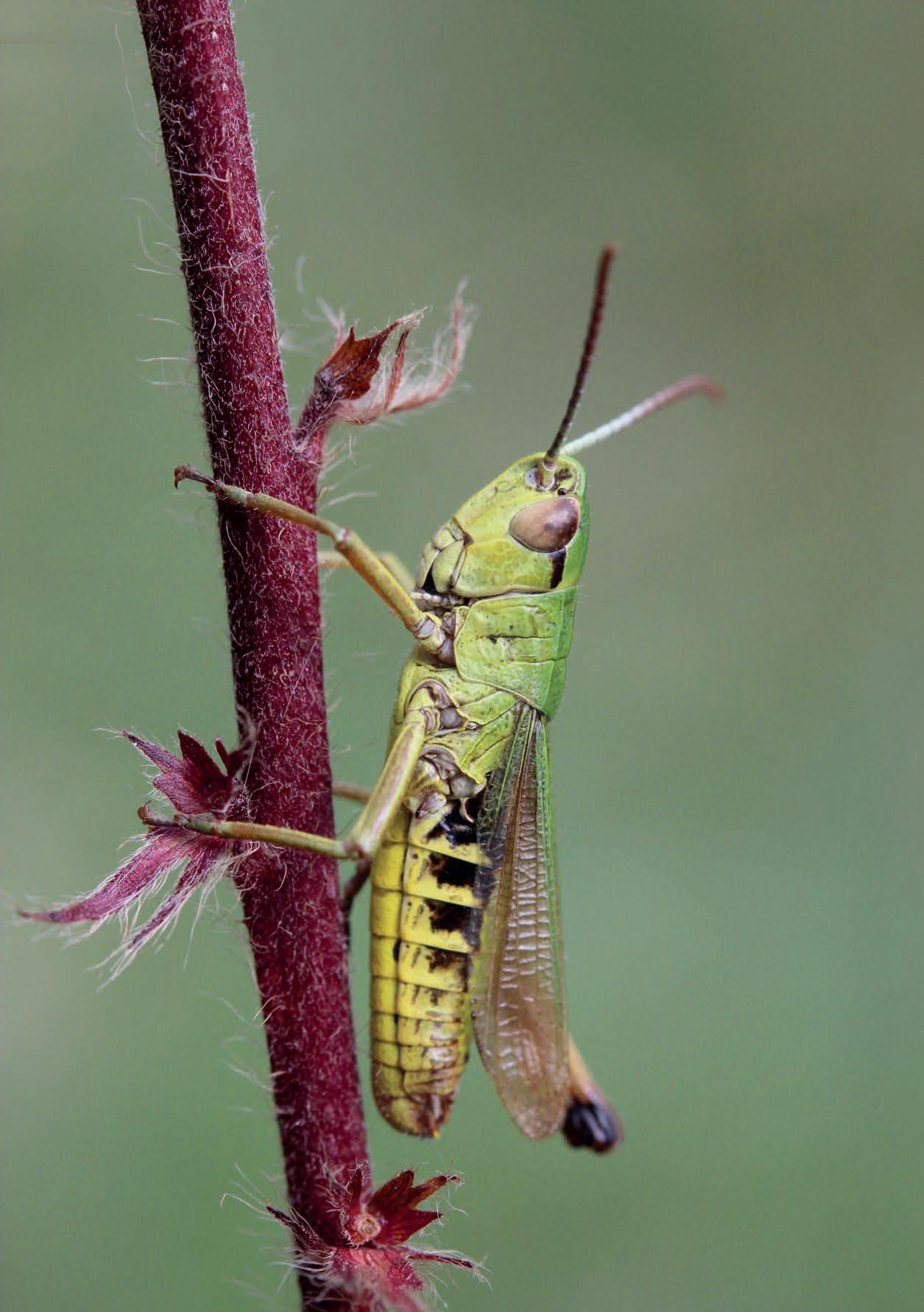
Where chirps, clicks, and calls fill the air
CARMEN PERRY
Meadow grasshopper
From buzzing meadows to humming heathlands, Hampshire and the Isle of Wight come alive in summer with the sounds of grasshoppers and crickets. These tiny creatures add their voices to nature’s orchestra, their vibrant stridulations becoming a quintessential part of the season’s soundscape. Here are six reserves where you can experience this natural symphony:
1 Arreton Down Nature Reserve, Isle of Wight
Arreton Down’s chalk grassland is a haven for invertebrates, including the great green bush-cricket Tettigonia viridissima. This large, vibrant green cricket is unmistakeable in appearance and sound; known for its loud, continuous song during warm summer evenings. The reserve also supports a variety of butterflies, such as the chalk hill blue.
Where: PO30 3AA
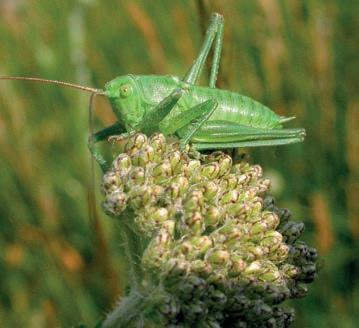
2 Milton Locks Nature Reserve, Portsmouth
This coastal reserve offers a mix of habitats, including grassland areas where the common field grasshopper, Chorthippus brunneus, thrives. Recognisable by its angular markings behind the head, very long wings and hairy underside and distinctive chirping, this species adds to the reserve’s summer symphony. The proximity to the coast also means visitors can enjoy a variety of birdlife alongside the insect chorus.
Where: PO4 8LB
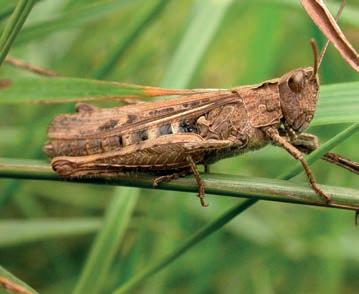
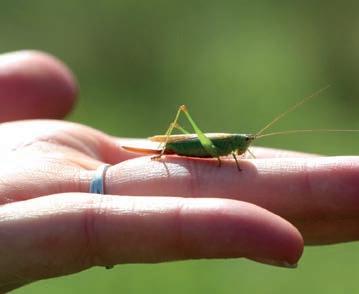
3 Hook Common Nature Reserve and Bartley Heath, near Hook
This expansive reserve features wet and dry heathlands, oak and birch woodlands, and is renowned for its invertebrate diversity. The long-winged conehead is one of the smaller bush-crickets, a species that favours wet heath with thick Molinia cover and can be found here and heard quietly buzzing in the background. Its presence adds to the rich tapestry of sounds and sights that make this reserve a must-visit.
Where: RG27 9HD
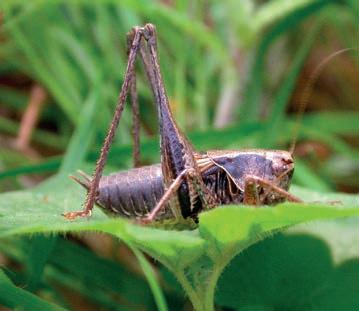
4 St Catherine’s Hill Nature Reserve, Winchester
Perched above the historic city of Winchester, St Catherine’s Hill is a chalk downland reserve renowned for its rich biodiversity. The sun-warmed slopes are home to various grasshopper and cricket species, including the dark bush-cricket Pholidoptera griseoaptera. This species is known for its irregular, scratchy chirps, often emerging from within bramble, reminding us of the vibrant insect life here
Where: SO23 9PA
5 Pamber Forest Nature Reserve and Upper Inhams Copse, near Tadley
The woodland grasshopper, Omocestus rufipes, with its reddish legs and abdomen, thrives in sunlit clearings like those created by coppicing at Pamber Forest. Its repetitive song begins as a series of slow clicks, rising in rhythm and volume for 5–10 seconds before vanishing into silence.
Where: RG26 3EQ
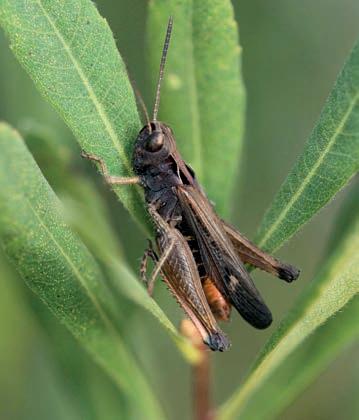
6 Swanwick Lakes Nature Reserve, near Fareham
This peaceful reserve features sunny meadows and grassy paths where the meadow grasshopper, Chorthippus parallelus, thrives (photo opposite). Its gentle song, a regular ‘rrrr’ sound, adds a subtle rhythm to the reserve’s acoustic backdrop, blending with birdsong and the rustle of leaves.
Where: SO31 7AY
DID YOU KNOW
Grasshoppers and crickets don’t just sing for fun, they’re communicating. Male grasshoppers produce sound by rubbing their legs against their wings, while male crickets create sound by rubbing their wings together (a process called stridulation) to attract mates, defend territory, or simply state their presence. Each species has its own distinctive tune, and on a warm summer day, their overlapping songs create a wild and wonderful chorus.
• For more information on grasshoppers and crickets in the region, visit hiwwt.org.uk/wildlifeexplorer
CHRIS BUTTON
Great green bush cricket
Woodland grasshopper
Long-winged conehead cricket
Male dark bush cricket
grasshopper
LIANNE DE MELLO
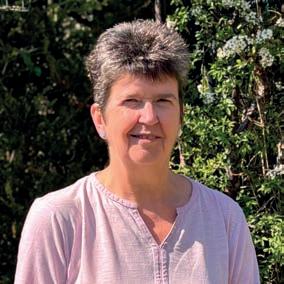
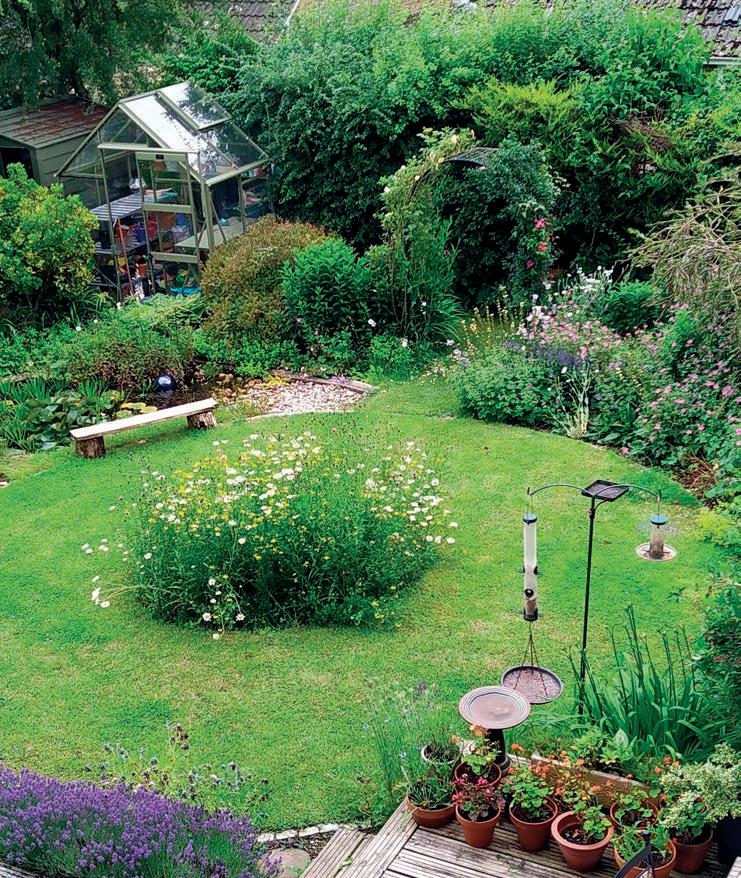
Growing greener
Sara Mills discovers how the Trust’s Garden Champions are transforming outdoor spaces for wildlife
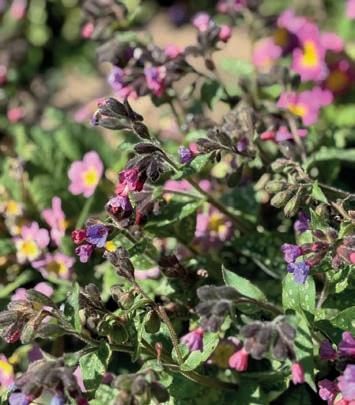
It’s early spring in the suburbs of Swanmore. Among the pulmonaria, the bees are already searching for pollen in the bright tubular flowers.
Jane Rankine, a Wilder Gardens Champion for the Trust, is guiding me around her abundant outdoor space explaining how she’s changed the way she gardens to attract more wildlife, adopting a more environmentally aware and mindful attitude.
Three years ago, Jane applied to become a Garden Champion after spotting an advert on Instagram. She was then introduced to the Trust’s Wilder Gardens Group, a network
Left: Garden Champion Jane Rankine and her ‘wilder’ garden.
of garden experts who care about supporting all kinds of wildlife and improving biodiversity in their gardens. As a Champion, she now shares her knowledge with clients who are keen to make their gardens more wildlife friendly. Her advice might include ‘which uninvited weeds to allow to thrive’, or ‘how to provide shelter for breeding butterflies by leaving some longer grass or creating a dead hedge’. In fact, her stack of coppiced hazel is the perfect home for a multitude of insects, providing refuge and food for small mammals, reptiles, amphibians and birds. “As soon as I finished making it, the robin and the wren were already landing on it to investigate,” she explains.
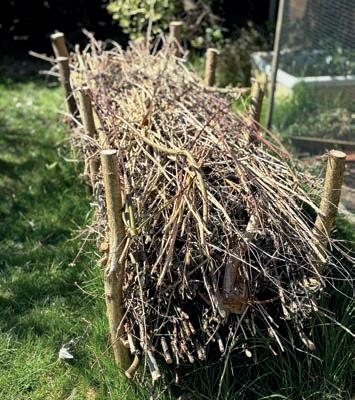
Jane grows a wide variety of plants, some of which are wild: vibrant foxgloves, primrose, and a prickly dog rose which produces red rose hips, popular snacks for birds and small mammals. While the herb border isn’t strictly wild, the insects ‘adore’ the fragrant thyme, rosemary and yarrow. Climbing the fence is wild clematis, known as Traveller’s Joy (or Old Man’s Beard) an important food source for moths, and around the pond, common blue caterpillars feed on bird’sfoot-trefoil, and the butterflies enjoy the nectar from its slipper-like yellow flowers when they emerge.
“Things find their way,” Jane explains, “I tend to just let them get on with it and only remove things when they become a problem. Every time I get a gap, I ask myself, ‘what’s good for the wildlife?”
Jane has been invested in wildlife from an early age when she lived in the
Pulmonaria
Dead hedge
What is Wilder Gardening?
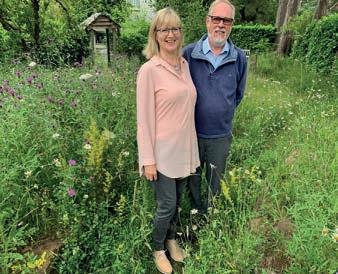
Wilder gardening is about supporting wildlife of all kinds – working with nature rather than against it. Focussing less on manicured gardens and more on the beauty and value of wildflowers and the intricacies of the lifecycles of invertebrates and native mammals, it aims to attract more wildlife. Useful habitats might
countryside and walked the country lanes to school, inspecting the grasshoppers and crickets along the way. But how does she inspire others?
“The people I visit want to make a difference. I give them the ideas and they choose what to put into practice. No matter how big or small a garden – if you provide a habitat for wildlife, it will come.”
This is true of one client’s 5mx5m garden. After recommending they add a small pond, frogs arrived within a few months. In her own garden, a bird box hidden in a hedge is home to a family of blue tits. Red mason bees, which are brilliant pollinators, nest in the bee tubes. The compost bin provides nutrient-rich mulch for the soil, attracting slow worms which eat unwanted visitors like slugs and snails. Come summer, the pond (filled
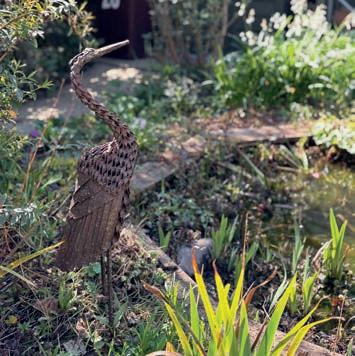
include a pond with native plants such as flowering rush or leafy litter for hedgehogs to nest in during hibernation. Another couple of Wilder Gardens Champions, Jane and Steve Page (left), describe wilder gardening as ‘an enriching experience with more reward and interest’ than traditional gardening, adding: “There may be the usual garden plants and attractive beds and borders with dense, diverse and layered planting to provide shelter and forage for wildlife above and below ground. But there’ll be less mowing, trimming, weeding and tidying, and there won’t be any peat or chemicals such as herbicides or pesticides. We garden with more purpose now – optimising our patch for biodiversity and for a reduced carbon footprint, doing our bit for nature and the climate crisis.”
Client feedback

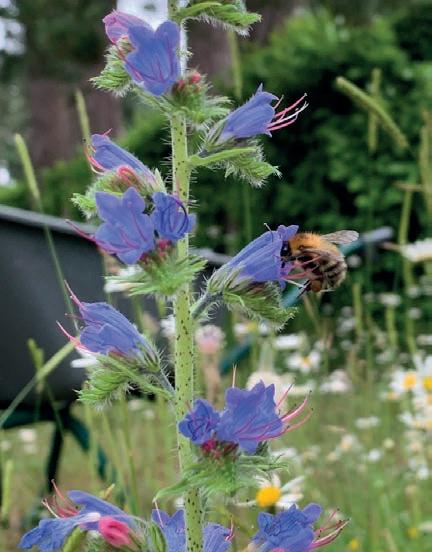

Esther in Alresford: “We really enjoyed your visit and feel inspired to get going. We realise it is a long-term project that we need to keep chipping away at and improving and we’re going to spend some time looking closely at all the different spots [we can work on].”
Benny in Chichester: “Thank you for all your suggestions, your time and encouragement. I will certainly set about implementing your ideas. When viewed by a new set of eyes, many more possibilities and improvements become so obvious!”
from the water butt) will be thriving with common darter dragonflies, damselflies, water mint, diving beetles, ramshorn snails and newts – “we’ve had newts every year since we established it”.
Jane, who has counted up to 122 different types of fauna in her garden, says a healthier ecosystem benefits both wildlife and the overall environment.
“If more people have wilder gardens, more wildlife will have a home,” she adds, “Even the simplest things make a difference.”
•To book a free a garden consultation with a Champion, visit: hiwwt.org.uk/ gardening-advice
Get involved
If you have good gardening knowledge and are interested in receiving training to become a Wilder Gardens Champion, visit hiwwt.org.uk/team-wilder

5 ways to support local wildlife
● Keep a wildflower patch and some long grass to help butterflies breed
● Add log piles, bee tubes or bird boxes
● Leave leaf litter under the native hedging and a tree or two
● Introduce climbers to add plants in small spaces
● Build a wildlife pond with native plants
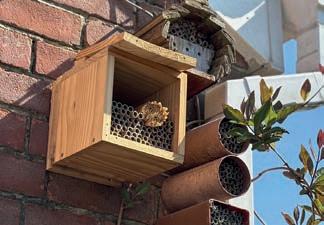
Jane’s wild pond
A bee feeding on Viper’s Bugloss. JANE PAGE
OUR WILD LIVES
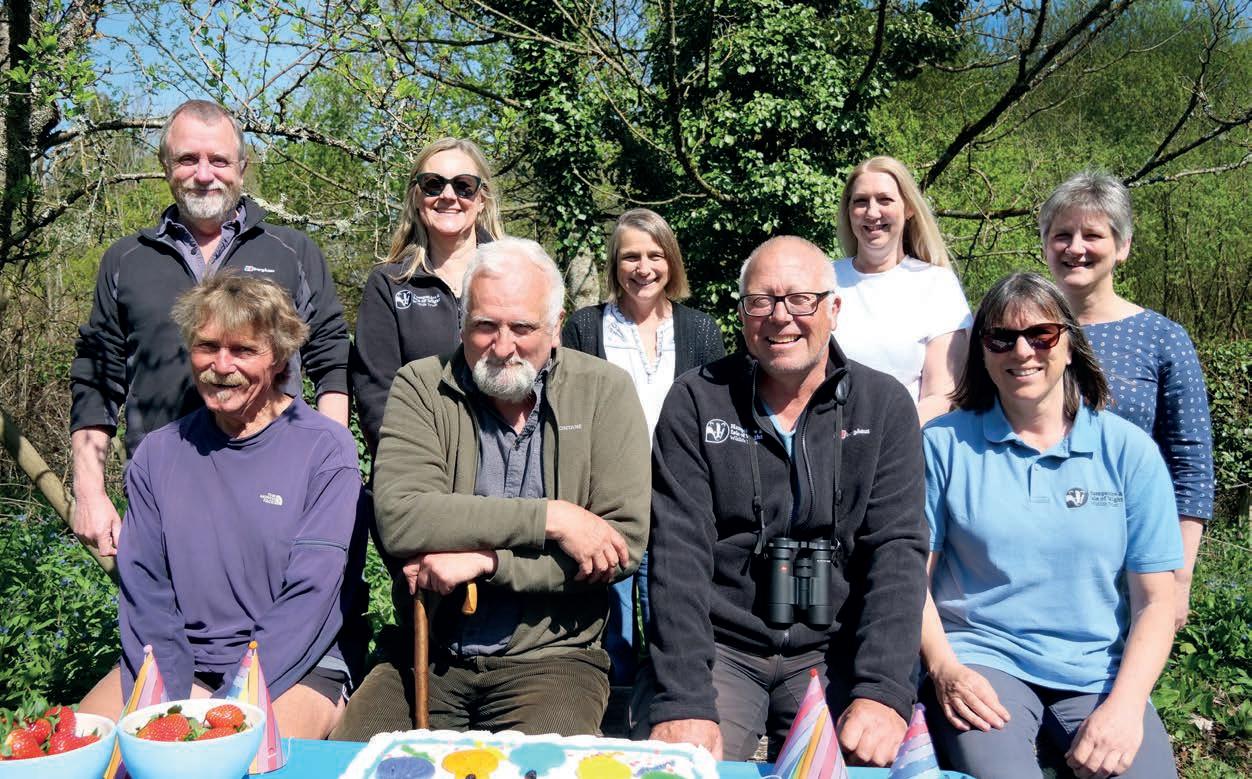

Never standing still
In this special celebratory feature, we ask our longest-serving employees (with 331 years’ service between them) for their best moments during their varied careers with the Trust.
Jess Pain, Capital Works Manager and Technical Specialist, 38 years
“Having spent nearly 20 years in industry, I wanted to try something new to include my passion about nature. When I joined the Trust in 1987, I became the sixth member of staff – it’s a bit different now!”
Clive Chatters, Company Secretary, 36 years
“Most of our achievements have been due to hard graft over many years. There are no quick fixes or easy wins. My thoughts for the Trust now are concentrated on how we deal with an uncertain future and how we move to secure an environment where wildlife no longer needs our
constant interventions. We need a healthy economy and society where the needs of our co-habitees on this planet are respected. I retire from Trust work this year, but not from my commitment to the natural world.”
Graham Dennis (right), Reserves Officer, 34 years
“I’ve always enjoyed being at the sharp end of conservation, knowing that the management I do is critical for the wellbeing of the wildlife it is targeted at. I particularly enjoy monitoring wildlife, as well as having a crucial role in steering our work. It has provided an opportunity to witness some amazing, unforgettable
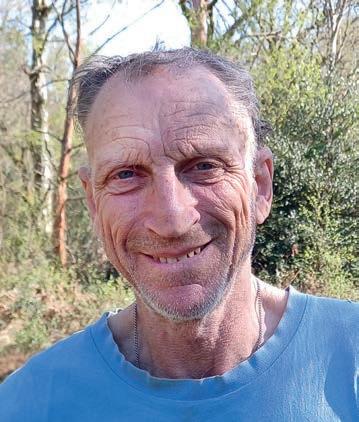
Front row (L to R): Jess Pain, Clive Chatters, Simon King, Clare Bishop, (back row L to R) John Durnell, Debbie Tann, Jo Gore, Lucy Killick and Liz Hood.
wildlife. Seeing the difference my work has made is all the inspiration I need.”
Simon King – Assistant Reserves Officer, Lower Test Valley, 32 years
“One of our biggest achievements has been the colonisation of breeding waders at Testwood Lakes after losing them to sea level rise at the Lower Test.”
Clare Bishop – Reserves Officer, Testwood Lakes, 30 years
“The Trust attracts lovely people with vast amounts of knowledge that they are happy to share, and you can get things done here rather than being tied up with bureaucracy. I’ve enjoyed developing team projects like building the first sand martin bank and the Bronze Age Roundhouse at Testwood.”
John Durnell, Director of Nature-Based Solutions, 28 years Three words to describe the Trust? Never Standing Still!
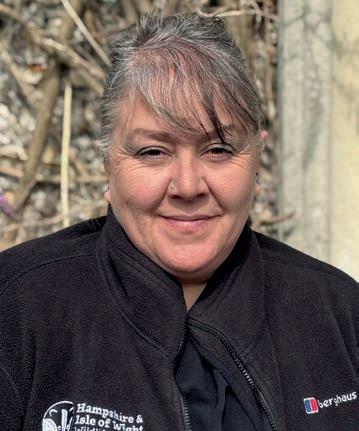
Tara Puttock (above), Facilities Manager, 30 years
“The people are a huge part of why I am here – both staff and volunteers and I’ve made some incredible friends here. Being office-based means you can sometimes lose sight of the impact of our work on the ground, so my favourite and most inspiring times are when I get to speak to our enthusiastic supporters.”
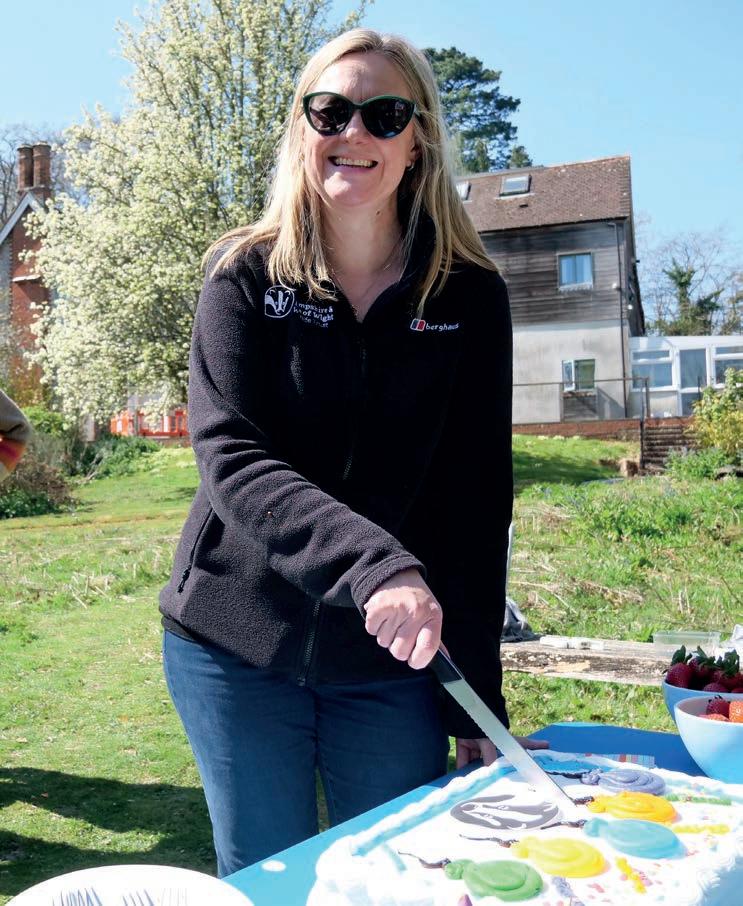
Jo Gore – Ecologist – 26 years
“I love working outdoors and seeing parts of the countryside I wouldn’t get to see outside of my role. I’m privileged to have seen and handled some of our two counties’ rarest species and love inspiring action to improve some of its most protected areas.”
Liz Hood - CRM & Data Insights Manager – 25 years
“The first time the income from Membership topped £1,000,000 was a real milestone! It’s mind-blowing to know that there are so many members and supporters who believe in us.”
Lucy Killick, Finance Manager, 25 years
“I feel privileged to have seen the Trust grow. Outside of my role, I’ve helped build the Roundhouse at Testwood, decorated the office, helped at Roydon Wood Fair, taken part in the Walk for Water Voles along the Itchen Navigation and the Great South Run.”
“Everyone at the Trust gives it their all with such passion and verve – it’s a thrill to see how much we’ve grown and developed over the years as a team –with many of us still here fighting the good fight.”
Debbie Tann (left), Chief Executive Officer, 27 years
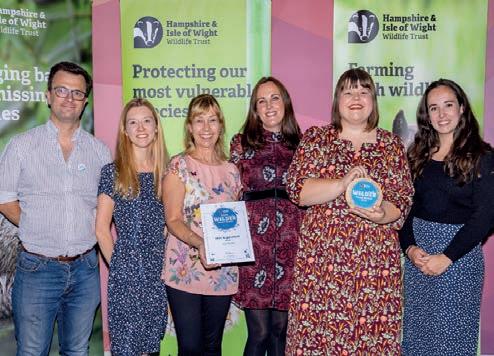
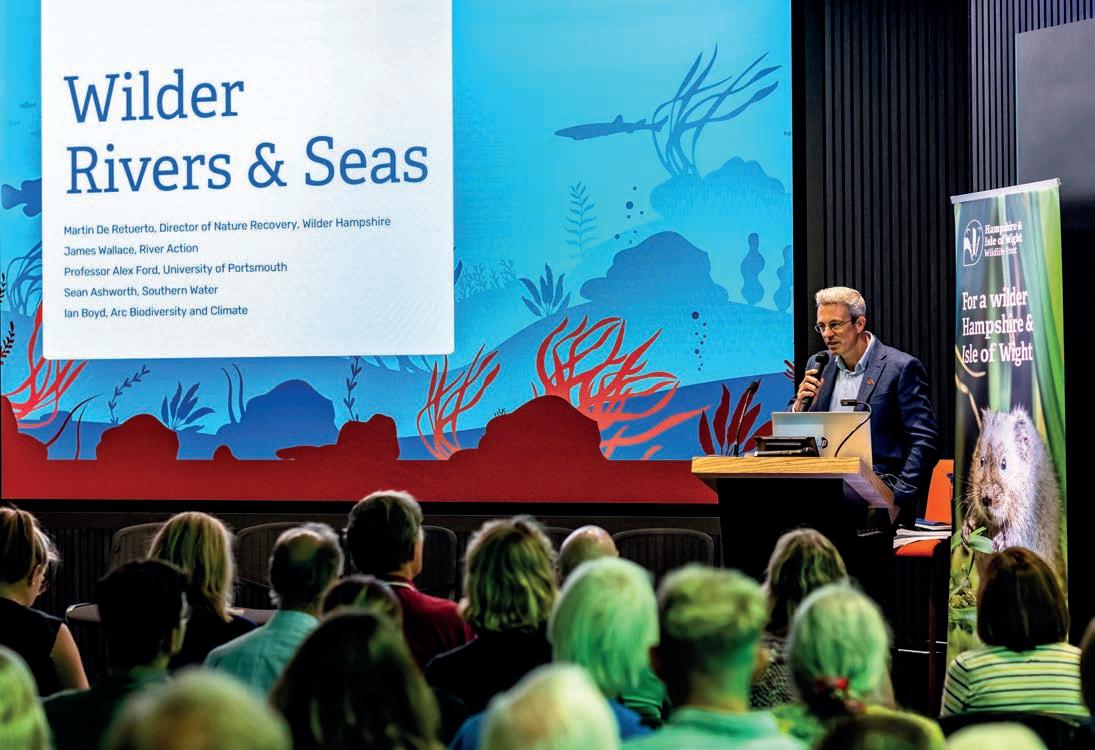
Wilder Conference & Awards
Join Hampshire & Isle of Wight Wildlife Trust for a powerful day of ideas, discussion, and celebration as we come together to accelerate action for nature.
This year’s conference marks a significant milestone: the launch of our refreshed Wilder strategy. Launched in 2019, Wilder 2030 set bold ambitions for nature’s recovery. Six years on, we’re taking stock, acknowledging the scale of the challenge ahead, and reigniting the urgency to drive nature-positive change — through the next four years and to 2040.


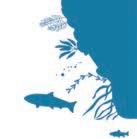
Hear from leading voices, connect with passionate communities, and celebrate those making a real difference across Hampshire and the Isle of Wight.

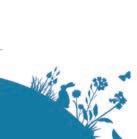
Thursday 23 October 11:45–17:30



Why attend?
Inspiration: Hear bold ideas from speakers, campaigners and landowners driving nature’s recovery.
Connection: Meet others working for wildlife and build lasting partnerships.
Ideas: Explore real projects and take away practical insights for local action.

The Point Theatre Eastleigh, SO50 9DE




Celebration: Following the conference, stay for the Wilder Awards to honour those making a difference for nature.
*Please note: This event follows our Annual General Meeting.
